Posts by Alyson Shane
7 Foolproof Content Promotion Strategies That Really Work
- by Alyson Shane
Spoiler alert: helping your audience find your content is harder than ever.
Search engines like Google are increasingly using tactics to keep searchers on the results page and off your site, and social media has become so crowded that whether someone sees your post or not can often feel like a shot in the dark.
And while there are other ways to get your content in front of your target audience (of course) a lot of them tend to fall into one of two categories:
- Somewhat effective, like posting a blog to your social media profiles and encouraging your followers to click through and read it.
- Too complicated, like creating detailed reports or doing interviews that might net you some traffic, but are unrealistic to do every month unless you have a dedicated team to manage it for you.
I’ve been publishing content online for 23 years, so I’ve seen lots of trends come and go, but there are some tactics that get results time after time - and that’s what this post is about.
A note before we go on: these strategies only work if your content is entertaining, informational, and valuable. People only want to read, share, and backlink to content that’s genuinely worth sharing, so don’t dial it in!
Now let’s get into it:
1. Email your audience
I often say that “getting someone’s email is like getting the spare key to their house.”
Think about it: even if you’re promoting your content on Google or social media, you’re still just hoping that your content will be seen by the right people and that they won’t simply scroll on by.
But someone who subscribes to your email list has already shown that they’re interested in what you have to say, and you can send it to them in a place that only a few can access: their inbox.
For example, when we publish a new blog post I include it in Starling Social’s weekly digital marketing newsletter. Not only does our content get a traffic boost from our subscribers clicking through to read our articles, but anecdotally I’ve noticed that our blog posts often rank higher in search results because search engines recognize the boost in engagement from the traffic we’re sending, too.
The trick here is to publish regularly and cover topics that you know your audience are interested in. We send a digital marketing-focused newsletter, so it’s easy to assume that the people who sign up to read it are interested in the topics we cover here on the blog.
We also publish regularly (two times a month, on average, but sometimes more). This gives us lots of opportunities to drive traffic back to our content.
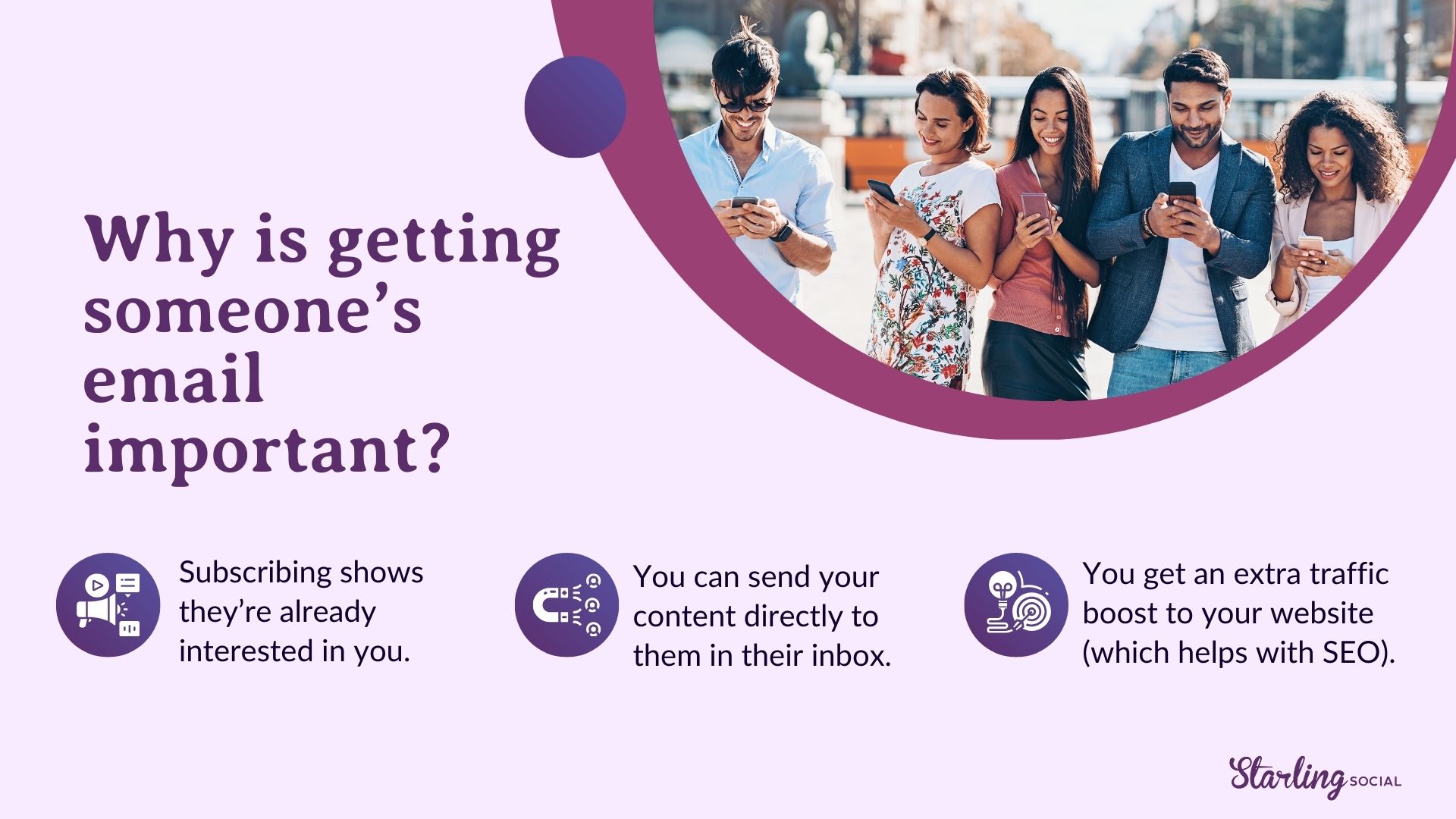
2. Repurpose your content
This is also known as a “bricks and feathers” approach to content promotion.
I’ve gone into this tactic in more detail in an earlier post on the blog, but the idea is to take a longer piece of content (like a blog post or a longer video) and break it up into smaller chunks, like social media posts.
So this blog would be a “brick” and the “feathers” are the posts and videos I’ll be creating after I’m finished writing this to promote it (and what’s inside) on our socials. Or, if I’ve been featured on a podcast (a “brick”) I’ll pull the audio and make Reels and TikToks with it (“feathers”).
An important note: one mistake I often see people making is just resharing the original piece of content on social media - but this is a mistake for a few reasons:
- Social media algorithms “throttle” posts that have links in them because they have an incentive to keep users on the platform, not send them away.
- People can’t interact with a link, so turning it into a video they can watch, an Instagram carousel they can swipe through, or even resharing it as a LinkedIn article they can access without leaving the site is a better way to encourage them to engage with the content you’re promoting.
3. Tap your team
92% of consumers trust word of mouth and UGC (user-generated content) more than other forms of traditional brand advertising, which makes sense: our brains are hard-wired to trust other humans (compared to a “faceless” brand).
So instead of just posting to your company page and socials, ask your team or employees to re-share your content on their own timelines, too.
An important note: just blind re-sharing won’t have the same impact as when someone takes a few minutes to write a thoughtful post about why the content has value.
This is especially important for company leaders and executives to do this since they tend to have large audiences on platforms like LinkedIn. At Starling Social, our favourite approach to helping clients do this is by creating Mad Lib-like templates their team can use to take the guesswork out of what we’d like them to say.
Once the post has been shared, encourage others in the company (other executives or employees) to like, comment, and re-share it to their own profiles to boost its visibility even higher.
4. Guest blog (but with grace)
You may have been the recipient of one of those spammy “hey I want to guest blog for you” emails before - and this isn’t the right approach.
Most people only offer to guest blog in order to earn backlinks, which means the content tends to be poorly-written and often doesn’t have any original ideas of value.
Instead of cold-emailing people, look for industry publications with a large audience and only submit a guest post when you have a unique or thoughtful perspective to share. Then (and only then!) should you link back to your content that’s relevant to what you’re saying.
Another approach is to publish your own post first, then reach out to other publications in your industry and explain in your pitch how you’d like to expand on that topic.
That way you’re not just repeating yourself; you can earn a reputation as an industry thought leader and earn those valuable backlinks to your content.
5. Partner with influencers or other brands
Working with influencers or other parallel brands in your industry is an easy way to help your content get discovered by more people. There are three main ways to do this:
- Hosting webinars
- Doing podcast/video interviews
- Doing blog post interviews
You can either work with someone in your niche and invite them to be interviewed by you, or to partner with you on a project, or you can develop relationships with others who will feature you.
I can personally attest to how effective this strategy is. I’m interviewed on a podcast every 1-2 months, on average, and I deliver a workshop or webinar at least every 2 months in partnership with several nonprofits and brands in parallel niches to my own.
This not only helps me promote Starling Social’s content to a wider audience, but also positions me as a subject matter expert which reinforces the value of the content I share.
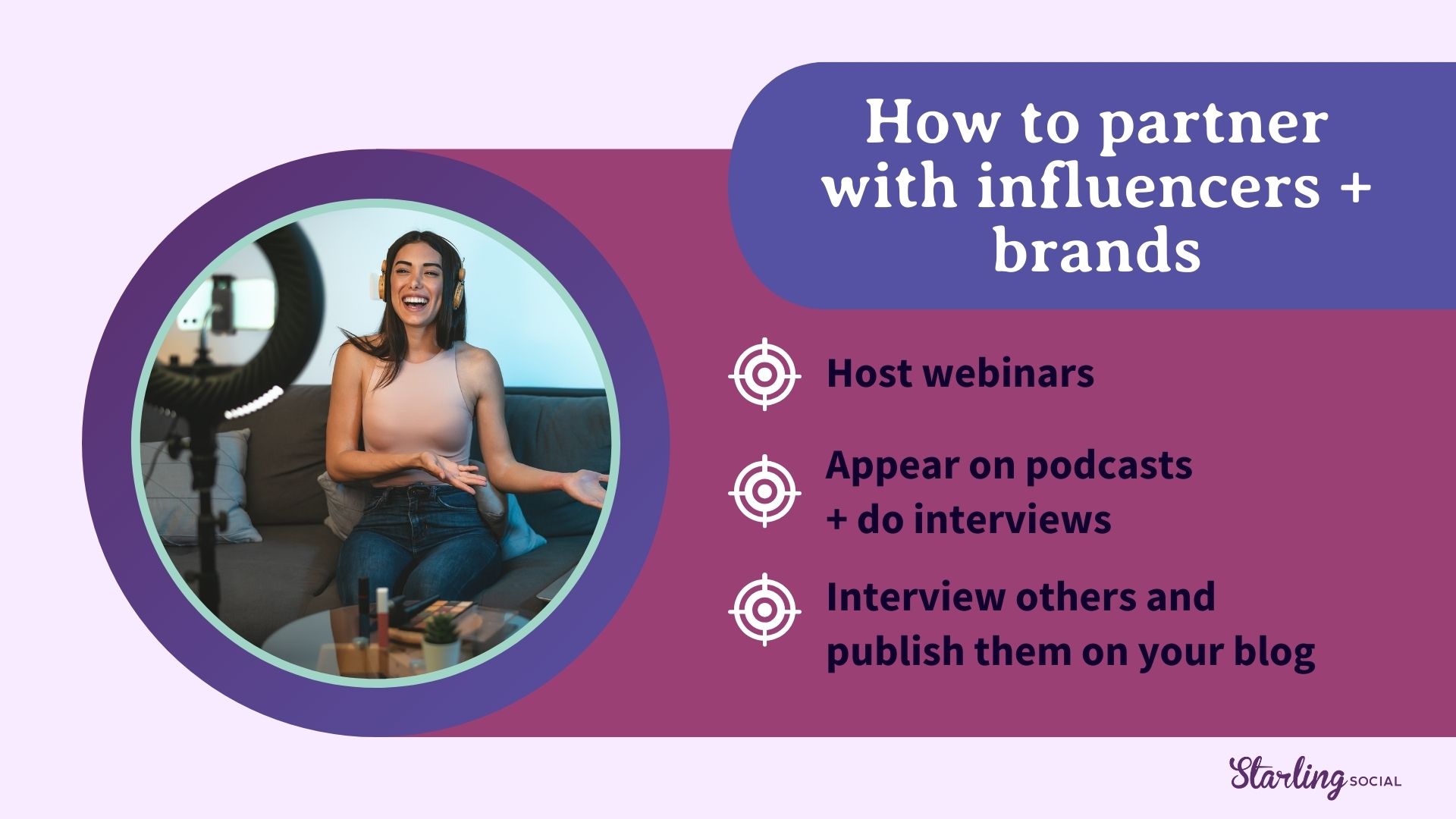
6. Cross-promote with other newsletters
Remember how I said “getting someone’s email is like getting the spare key to their house”? Well getting featured in someone else’s newsletter is like that, but on steroids. Here’s why:
- People love when their content is promoted
- People tend to reciprocate when you do them a favour
If you promote someone else’s content to your audience, they’re likely to reshare yours, too.
A few years ago I started reaching out to industry associations and nonprofits asking them if they have events or content they’d like Starling Social to feature, which has landed our blog posts in over a dozen of their monthly newsletters to their members as a result.
The trick here is to lead with offering, not asking.
6. Run paid ads
You probably knew this would be in here somewhere.
Most people don’t share sales-driven content unless it’s really valuable, so often paying to show your content to the right people is an effective way to help the right people see it - this is because ad targeting allows you to specify exactly the type of audience you think will want to see it.
An important note: knowing where to run your ads is a key part of this tactic. LinkedIn is the best place to share B2B (business-to-business) content, and Facebook, Instagram, and TikTok are better for B2C (business-to-consumer content).
If you think about why people use these platforms, this makes sense: most of us don’t go on TikTok or Instagram when we’re thinking about work or business, whereas 4 out of 5 LinkedIn members drive business decisions.
So if you’re going to invest your marketing dollars in running ads to promote your content, make sure you’re promoting it to the platforms where your audience is spending time.
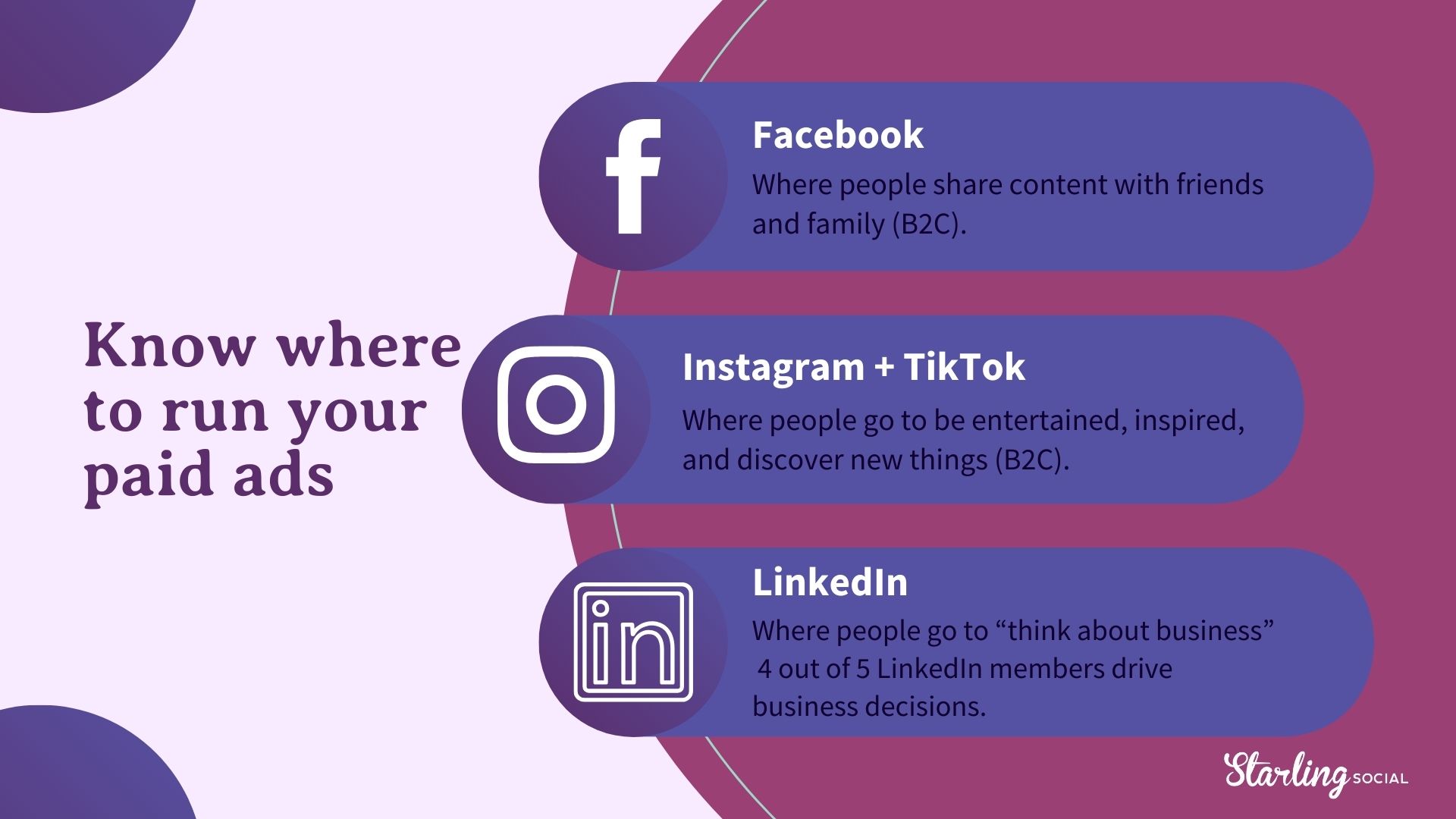
8. (Bonus!) Re-promote your old content
Do you have an older post that’s still relevant? This is known as “evergreen” content.
Evergreen content = content that focuses on a topic that’s already relevant, regardless of the season or news cycle. The term comes from the evergreen, a plant that stays “ever green” all year round (get it?)
If you have evergreen content lying around, link back to it in new content you publish or reshare it using the tactics outlined in the post above. Sometimes just the process of resharing it and sending more traffic to the page can improve your search engine rankings.
Start promoting your content today
Using these strategies can help you get more visibility for your content, but remember: your content needs to be engaging, entertaining, and valuable.
(Hint: don’t just churn out content using AI and hope for the best!)
If the thought of creating high-quality content sounds overwhelming, you’re in the right place because we can help! Starling Social is led by a seasoned content marketer (me) and made up of a team of creative and high-quality copywriters who have the experience to make your content shine. If we sound like your dream copywriting team, book a discovery call today!
Black Friday & Cyber Monday 2024: Trends, How to Prepare, and How to Sell More in 2024
- by Alyson Shane
If you’re gearing up for Black Friday and Cyber Monday, you’re not alone. According to Retail Dive, nearly 60% of consumers are already scaling back on their regular spending habits so they can take advantage of all the sweet, sweet deals this shopping season will offer up.
In fact, 76% plan to maintain or even increase their spending this season, making Black Friday/Cyber Monday (BFCM) the perfect time to sell more of your products and services.
The BFCM weekend is the biggest shopping event of the year, but a successful sales campaign is more than just adding some discounts to your website — you need to stay ahead of the curve and include the latest trends into your marketing strategy.
Below are some of the most important tips you need to know to sell more, increase customer loyalty, and attract new buyers to your brand. Let’s explore:
Black Friday/Cyber Monday 2024: Trends and Predictions
From artificial intelligence to Buy Now, Pay Later options, here are three trends we anticipate will shape the holiday shopping experience this year.
1. Plan for early promotions and extended sales
According to Experian, almost one-third of holiday sales took place in October 2023.
This trend probably isn’t going anywhere, especially since more brands are extending the BFCM into the following week (or even the week before).
If you’re looking to fire up your sales early, consider doing “Pre-Black Friday” promotions and leaning into “Cyber Week” deals for items sold through your website.
2. Offer flexible payment options at checkout
One trend we’re seeing is the rise of Buy Now, Pay Later (BNPL) options at checkout.
If you’re been on websites like Wayfair or Shein lately you’ve probably already seen these options, which allow customers to pay in instalments or even defer the full payment amount to a later date.
This tactic is especially useful if you sell big-ticket items like furniture, clothing, expensive jewelry… you get the idea. You can offer these incentives by integrating tools like Klarna, Afterpay, and Affirm into your e-commerce platform, and once they’re on your website, make sure to highlight that these options are available in your marketing push, too.
3. Lean into AI-driven customer support
According to research done on BFCM spending last year, AI likely contributed $51 billion to online global sales, so we can expect to see this trend of using AI-powered tools to continue this year, too.
Some ways you can integrate AI into your BFCM marketing planning include:
- Using chatbots to address customer’s questions and issues in real-time.
- Personalizing product recommendations.
- Doing pricing research against your competitors (tools like Prisync are great for this!)
- Using tools like Klayvio to create customized, AI-driven email marketing campaigns.
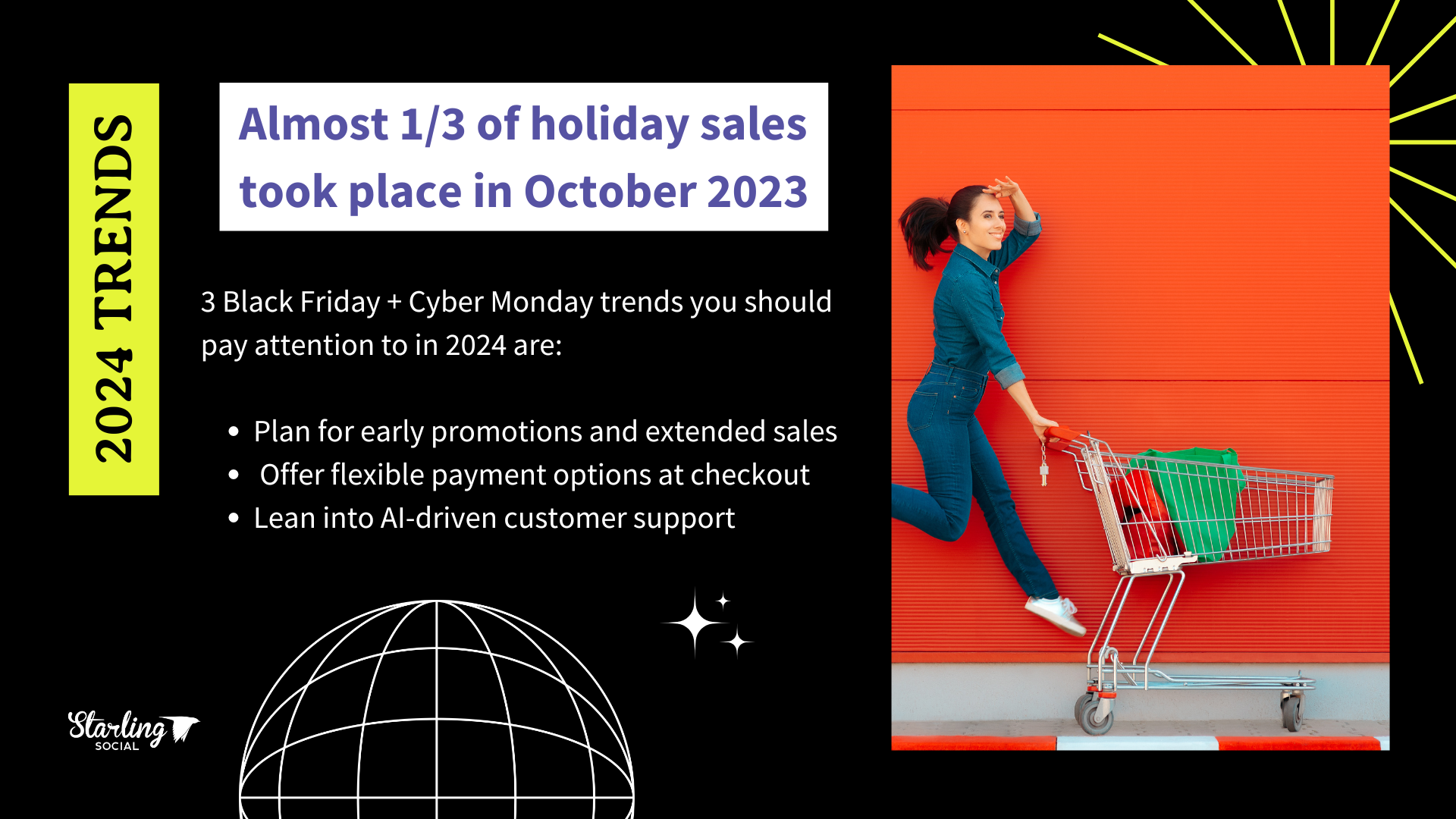
Black Friday/Cyber Monday 2024: Tips for Success
Here are some of the hottest strategies to help you level-up your BFCM sales success this season:
Start building your marketing plan early
Like, right now! (We can help with this.)
Start promoting your BFCM offers on your social media and through your newsletter as soon as Halloween is over. Some ways you can build excitement include:
- Countdowns
- Previews and sneak peeks
- Early access deals for subscribers and returning customers
- New customer incentives and savings
- Referral codes to existing customers spread the word about your products
Lean into “Flash Sales”
Creating a sense of urgency is one of the most effective tactics to enhance conversions, both during BFCM and year-round.
Use countdown timers on your website and in your marketing emails to remind customers how much time is left for a deal.
Staggered promotions that evolve throughout the day can also encourage repeat visits and incentivize customers to add more to their cart, too.
Make your brick-and-mortar experience memorable
Lots of customers still love the feeling of an in-person shopping experience, especially when it comes with special incentives.
Host exclusive in-store events with offerings like early access to discounts or special product launches (potentially with gifts).
Even small special details, like free samples or gift-wrapping, can help get more people through your door.
Offer mobile-exclusive deals
Do you have a mobile app? Then don’t miss out on the chance to attract more downloads and purchases through it by offering app-exclusive deals.
Encouraging customers to buy through your app also allows you to establish a direct connection with them and can open up other marketing opportunities like push notifications on flash sales and limited-time offers.
Use “Retargeting” to reconnect with customers
It’s normal for customers to browse your site without buying anything, especially during BFCM when they may be comparing options across multiple websites.
“Remarketing” is the process of reconnecting with people who’ve visited your website through Google Ads and Meta Advertising, so those pants someone viewed yesterday will show up in their Instagram Stories or at the top of their Google search feed, which might bring them back to buy.
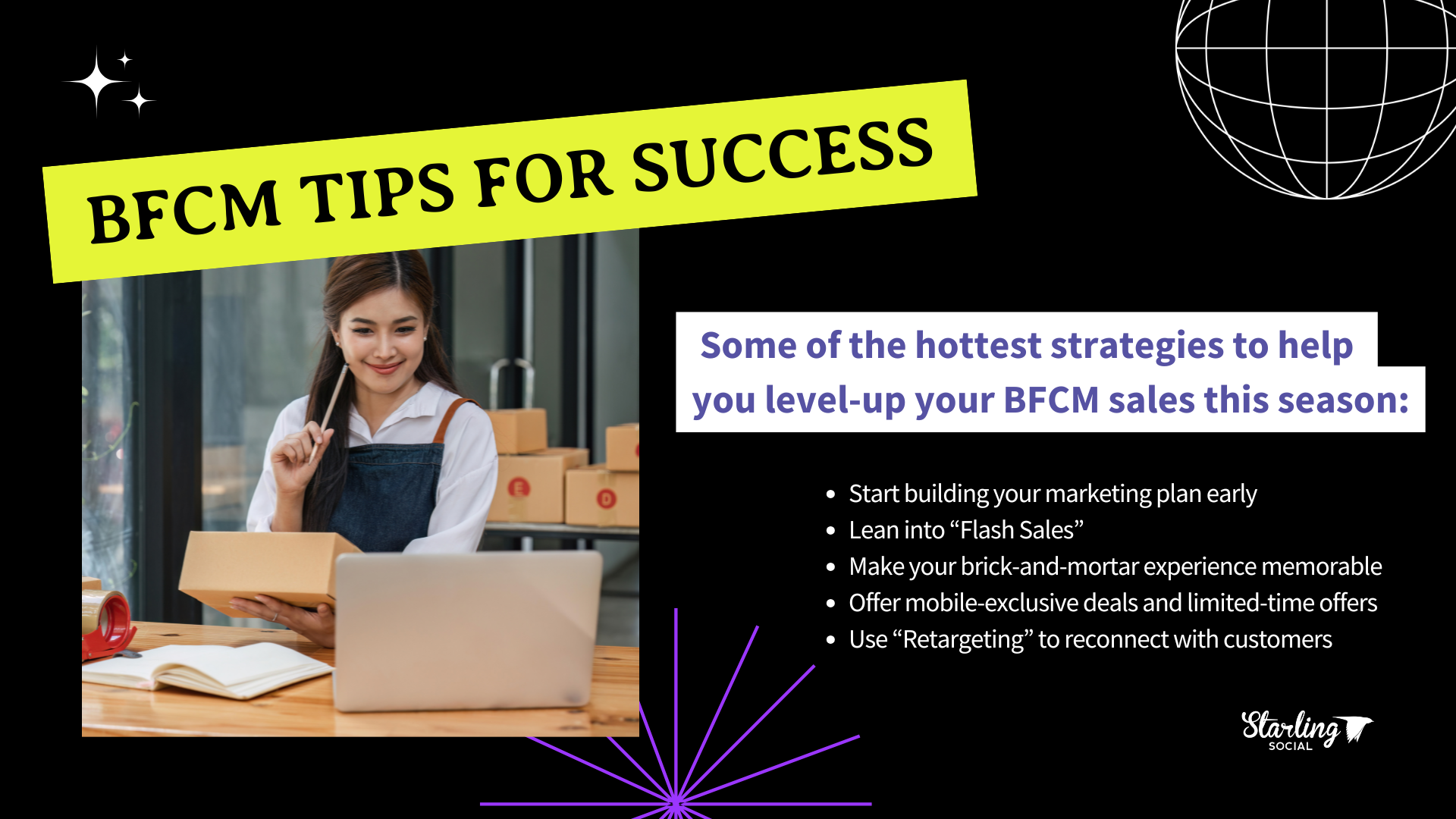
Are you ready for BFCM 2024?
BFCM 2024 is set to be another blowout shopping season, so start your planning now and use these tips to make sure this BFCM is your most successful one yet!
If you need help getting your marketing plan in order, we can help! Drop us a line and let’s build a winning BFCM strategy together.
Meet Alyson Shane
- by Alyson Shane
If you’re here, you probably had some type of interaction with our Founder, Alyson Shane. Whether you read Starling’s newsletter, follow our social media pages, heard her on a podcast, know her personally, or had a chance to work with her — you know this woman means business.
Not in the traditional sense, though. While she has the traits of a classic type-A person, Alyson puts her whole heart into every part of her life. When you ask her about her interests, you can expect to have at-length conversations about everything she loves, because this woman does her research and cares a lot. The belief that details matter extends through her work, hobbies, and relationships — which leaves everyone in her wake knowing whatever it is, if it involves Alyson, it’s taken care of.
If you’re considering working with our team or just want to read more about one of the marketing powerhouses in Winnipeg, stick around to find out what Alyson is all about, dive into Starling Social’s past, and see where we’re headed in the future.
Personal Life
Alyson embodies the spirit of Wolseley (Winnipeggers, iykyk). She loves to garden, read, and ride her bike around the city to visit local shops, breweries, and The Forks.
She also makes art in her spare time.
“I draw, paint in acrylic and gouache, and I do art journaling where I “freeflow” write out my thoughts, then explore whatever comes out by covering them with paint, collage, and other mixed-media materials. I picked this hobby up during the pandemic, and it’s done wonders for my mental health.”
She’s also a gamer. Alyson worked at EB Games (now GameStop) in her late teens and likes to unwind by playing the latest Zelda title or weird indie games like Night In The Woods, Boyfriend Dungeon, and Untitled Goose Game.
(If you haven’t played that last one, she can’t recommend it enough!)
Work Life
Before starting Starling Social, Alyson worked in Accounts Payable, if you can believe it. That cemented in her mind that she did NOT want to work in accounting. Much to her parents’ disappointment, she quit her “safe” government job to pursue a degree in Rhetoric, Writing & Communications from the University of Winnipeg.
After that she worked at a handful of local marketing agencies around the city (some big, some small) in various roles related to social media content creation, copywriting, and account management.
“While I’m grateful for the time I spent working those jobs, they all taught me a lot about the kind of work environment I wanted to work in (hint: it wasn’t any of those), as well as the kind of work/life balance I wanted to have.”
Starting A Business
A writer at heart, Alyson leveraged her passion and turned it into her marketing superpower.
Starling Social grew out of a handful of copywriting and social media contracts she took on in 2014, but within a year, Alyson had taken on so much work that she realized she needed to start building a team to help her manage the workload.
Fortunately, her boyfriend, (now husband) John, already had over a decade of experience running multiple businesses, so she was able to lean on him for advice and guidance — and still does! She says she’s lucky to be able to “nerd out” about her business with him.
To help with the transition, Alyson read a lot of books and articles about leadership, management, and process. Some of her biggest influences have been “The Marketing Agency Blueprint” by Paul Roetzer (which she actually read while she was working for an agency, which might have been a sign in hindsight), “Start With Why” by Simon Sinek, “How to Win Friends and Influence People” by Dale Carnegie, and “Crossing The Chasm” by Geoffrey A. Moore.
In case you haven’t picked up on it, Alyson loves working on projects that require strategy and research. Social media audits, developing campaigns, and putting together documentation to pass along to the team are her favourite things to do.
“I had a really good manager at my last job before I founded Starling who taught me the importance of having everything written down in advance — this means I’m able to clearly articulate my thoughts and break down complicated concepts quickly and easily so the team can execute them flawlessly.”
After 23 years (and counting) of publishing content online, she still loves researching and staying at the bleeding edge of the industry, so any opportunity to dig into the latest trends, changes to social platforms, and strategies feels more like fun than work.
Favourite Projects (So Far)
What Brings Us Here
We partnered with the National Film Board on a project that featured stories behind Indigenous-led community action in Winnipeg.
WBUH was a companion piece to the award-winning short documentary film this river, created by author and filmmaker Katherena Vermette and NFB producer Alicia Smith, and featured profiles of volunteers of Drag the Red and Bear Clan Patrol, both grassroots MMIWG and MMIP movements in our city.
We developed a social media strategy, consulted on content, and managed all aspects of the social media component of the project. Reading the personal stories of participants in the project was eye-opening and sometimes gut-wrenching, and she still considers it to be one of the most important and impactful projects we’ve worked on to date.
This Place: 150 Years Retold
We partnered with Portage & Main Press/HighWater Press to develop the launch strategy for “150 Years Retold” a graphic novel anthology which features Indigenous authors and illustrators and explores Canadian history through the perspectives of Indigenous peoples.
We created a really robust campaign that included developing all assets and the strategy for social media, multiple contests organized in partnership with Indigenous creators across Canada, blog posts, interviews, and cross-promotional content with the authors and artists, email marketing campaigns, and ads for Facebook, Twitter, and Instagram.
It was a huge project and a lot of work, but not only did it lead to a multi-year partnership with the fine folks at PMP/HWP, but we also helped the book achieve #1 in Native Canadian Literature and #2 in Canadian Literature through pre-orders on Amazon.
Ad Campaigns for Siloam Mission
Alyson is a values-driven marketer and makes it a priority to work with nonprofit organizations locally and across Canada with the goal of helping our communities, so she’s really enjoyed this ongoing partnership with the folks at Siloam Mission.
She actually used to volunteer in their kitchen before Starling Social and related activities (teaching, speaking, etc.) started to take up too much of her time. Being able to give back to a nonprofit doing important work in her city by developing and managing their social media and Google Ads campaigns has a very special place in her heart.
“THE FAMILY CROW: A Murder Mystery”
This was one of the weirdest projects we’ve worked on and Alyson was over the moon to take it on!
Adam from Pucking Fuppet Co. reached out to her after she wrote a review of his one-man show for The Winnipeg Fringe. Not only did our efforts result in several sold-out shows, but the media we got to use to promote the show was super weird and quirky (aka, right up her alley).
As a former theatre kid herself, Alyson loves getting to support Canada’s arts community and was able to bring what she learned through Starling’s partnership with Adam and his team to a “Facebook Advertising for Performing Arts” course for ArtsBoost, a nonprofit who supports performers across Canada. How cool is that?!
Growing Starling Social
Looking back over the last ten years, the thing Alyson is most impressed with is her team.
Alyson never imagined herself as a person who would thrive as a manager, but her team helped her build a company culture that she’s very proud of, where we all feel heard, supported, and can collaborate on any kind of project. She says that isn’t just because of her!
“The hardworking people who sit down at their desks for Starling’s clients every day always bring 110% and I can sleep easy (okay, easier) at night knowing that I have a team of whip-smart humans behind me every step of the way.”
Alyson’s Four Biggest Business Changes
However, there are many things to be proud of about the company’s evolution over the last decade. Alyson shared the four biggest changes in her business since its inception:
Being Choosy About Our Clients
When agencies are just starting out, there can be a lot of pressure to bring every client possible through the door just to generate revenue, but finding clients who are a cultural fit is so, SO important.
If a potential client starts sending up red flags in the initial discovery call, I will talk to the team about how they feel, get their read on the situation, and if necessary, we make the decision to turn down the business together.
(Aka, we do a “vibe check” together.)
Refining Our Systems and Processes
My poor team hears me say, “if it’s not written down, it doesn’t exist” so often that I’m sure I must drive them crazy, but I live and die by this mantra.
Figuring out how to communicate, operate, and collaborate as a 100% remote agency has its challenges, of course, but this approach has paid off for us in spades, especially when Starling was first starting to scale up.
Now we have a documented, repeatable, and scalable process for every type of client, project, and deliverable, which not only increases our clients’ trust in us, but helps us communicate and be more transparent with them than if we were just winging it all the time.
Honing Our Values
When someone goes into this line of work, it’s usually because they like writing, or have an interest in creating content - and that’s great!
But being a business means we also have a responsibility to give back to our community and do good, which is why we’ve started sponsoring events like the QNET Leadership Conference, tournaments for the Epilepsy and Seizure Association of Manitoba, and the Winnipeg Women’s Community, among others.
Growing my team also means I have more bandwidth to give back professionally, too. I’ve been a volunteer with SPARK!, a local nonprofit who connects small NPO’s with businesses who offer their services pro-bono* since 2018, I’ve worked with Manitoba Music as a mentor helping emerging artists, and sit on the board of the Manitoba Chamber Orchestra, to name a few.
My team is also dedicated to supporting our community, and makes it a priority to work with and support LGBTQ2SIA+, Métis and Indigenous-owned businesses.
* I was awarded Volunteer Manitoba’s “SPARK Pro Bono Consultant Award” in 2021 for my volunteer work, which was a real honour.
Changing With The Industry
When Starling first started out we offered a pretty narrow slate of services: copywriting, social media management, and email marketing.
We started with these because they were my biggest strengths, but as the digital marketing landscape has changed over the years we’ve expanded to include social media ads, website development, video content development, branding, and Google Ads (PPC).
Some of these new services were introduced to meet our clients’ evolving needs, but generally speaking I started looking for team members who could meet these needs because I saw that we’d be pigeonholing ourselves if we weren’t proactive about growing and adapting as the industry changed.
Now, this doesn’t mean I’m the expert in all of these fields! I can read basic HTML and CSS, and I know just enough about Photoshop, InDesign, and how to run a Google Ads campaign to be dangerous, but I prefer to work with people who are experts in their respective fields rather than under-delivering (see my point below about knowing when to scale!)
Advice for New Digital Marketers
Know When To Scale
One of the biggest mistakes that new business owners make is not recognizing when they need to scale.
“I get it! Moving from a ‘solopreneur’ to a ‘manager’ can be an intimidating transition, and I definitely didn’t go into this thinking that I was going to lead a team.”
Alyson holds her work (and that of the people who work for her) to a very, very high standard, so when she realized that she couldn’t keep executing at the level she expected of herself, she brought on others who could help her maintain it.
Learn to Write Properly
Don’t rely on AI tools like ChatGPT to do your work for you!
I mean it: there’s a lot of low-quality content being churned out right now; before that was because a lot of people entering into the industry didn’t take the time to hone their craft, and now it’s because increasing amounts of people are cutting corners by letting an AI write their content for them.
Using AI seems like a good strategy at first, but it’s not a good look when your content sounds hollow and doesn’t have the unique, creative touch that the human brain brings to the art of writing.
The Future of Starling Social
In five years, Alyson hopes to be doing exactly what she’s doing right now: running a marketing agency that does work that she’s proud of and working with clever, passionate people.
“I love the work that I do and while there are always ups and downs, I’m legitimately excited to sit down at my desk every day.”
As a passionate traveller, where in the world she’s sitting at that desk might change over time. It’s one of the reasons why Starling is, and will always be, 100% remote.
“Flipping open my laptop or turning on my computer is still an exhilarating feeling — after 10 years in this business, all I can hope for is many, many more.”
If you have questions for Alyson, or want to talk about your next digital marketing project, you can contact her here.
How to Do Content Marketing Beyond Blogging: Podcasts, Webinars, and More
- by Alyson Shane
Written by Starling Social President, Alyson Shane
I’ve been publishing content online since 2002 and have watched firsthand as the world of content marketing has changed dramatically in that time.
Once upon a time we were all just a bunch of bloggers in the “blogosphere” listing our favourite sites on our blogrolls, but over the past decade-and-change the way and place we publish and share our content with our audiences has become almost unrecognizable from where I first started out.
So today I want to dig into the evolving landscape of content marketing: where it’s been, where it is, and where it’s going — all do you can develop a strategy that connects you with more of your target audience than ever before.
Let’s get into it:
Why Does Content Marketing Matter?
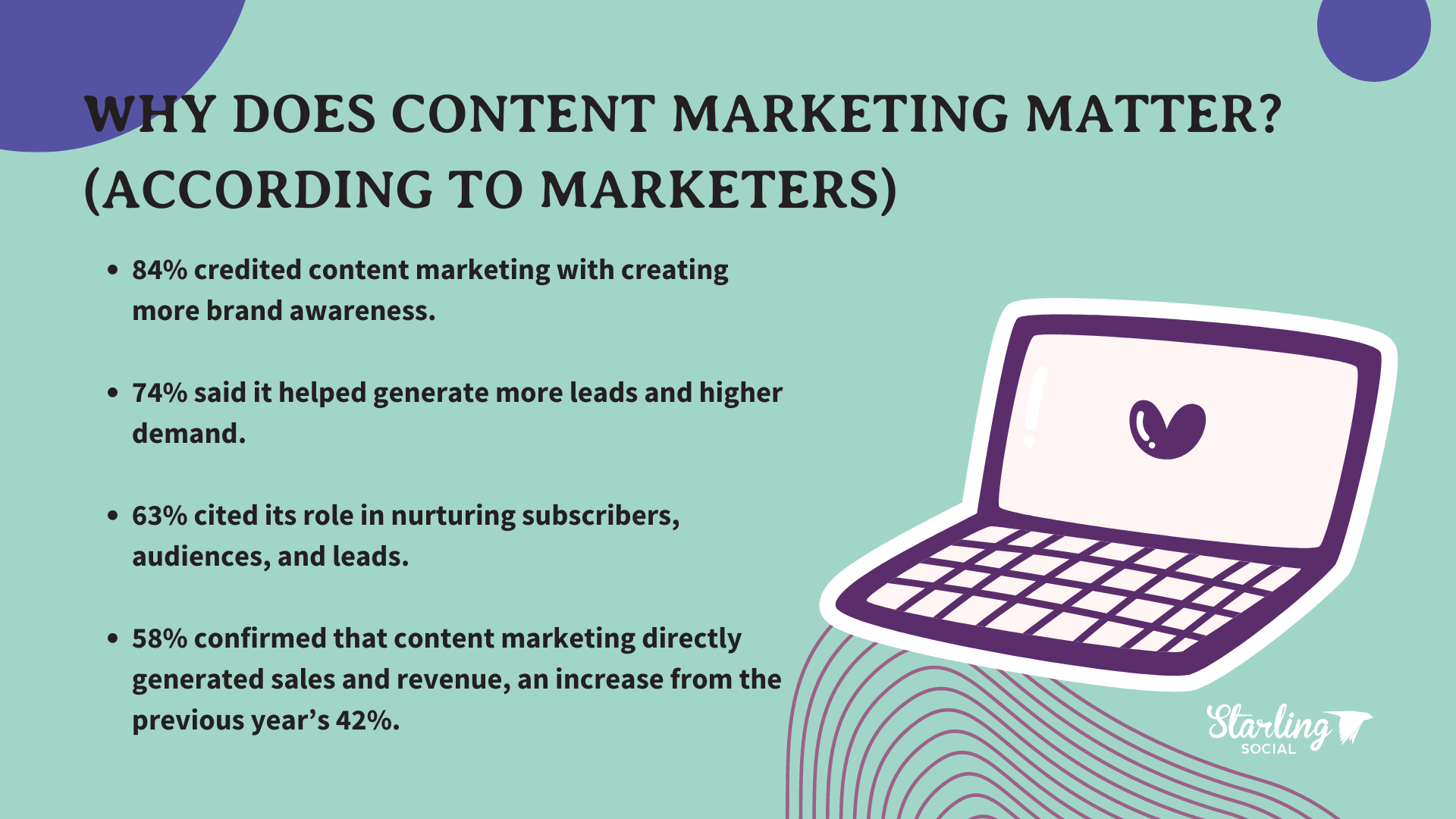
Content marketing describes a type of marketing that “involves the creation and sharing of online material (such as videos, blogs, and social media posts) that does not explicitly promote a brand but is intended to stimulate interest in its products or services” (thank you, Oxford Dictionary).
It’s also the most powerful way to continually reinforce your brand’s message, values, and convey the ways your products and services make your customer’s lives better.
But don’t just take my word for it, according to the Content Marketing Institute (CMI), marketers have been seeing success with content marketing across the board.
Here are a few stats to back that up:
- 84% credited content marketing with creating more brand awareness.
- 74% said it helped generate more leads and higher demand.
- 63% cited its role in nurturing subscribers, audiences, and leads.
- 58% confirmed that content marketing directly generated sales and revenue, an increase from the previous year’s 42%.
It’s clear that finding more ways to share your content with your audience has a net positive effect on your business, but before we dive into all the avenues available to you, let’s quickly review how we got to where we are:
The Evolution of Content Marketing
1994: The First Banner Ad
All the way back in 1994, AT&T ran a banner ad on HotWired.com and earned a click-through rate (CTR) of 44%. These results have the industry completely shooketh, and established a precedent for how companies would start turning to the internet to connect with their customers.
1995: Amazon Introduces Customer Reviews
Weird to think that Amazon has been around this long, but it’s true!
Allowing customers to say whatever they wanted about the products they were buying through the site created avenues for two-way conversations with brands that didn’t exist before.
It also opened up the floodgates for new opportunities for companies to gather real-time feedback from customers before social media exploded onto the scene.
1996: Microsoft Launches “NetMeetings” and Webinars
Although the term “webinar” wouldn’t be popularized until 1998, the first public “web conferences” were already gaining popularity.
Since then we’ve seen the introduction of more sophisticated tools like Google Meet, Zoom, GoToWebinar, ClickMeeting, and more.
1998: Google Changes Everything
Google and its PageRank algorithm is arguably one of the most important developments to ever happen to the internet.
By prioritizing a website’s “relevance” it changed websites from static spots online, to places where businesses regularly began to develop and publish content to improve their digital exposure, setting the groundwork for the SEO sector and brand visibility online.
1999: RSS Feeds
RSS feeds scrape content from sites you connect it to, allowing you to access information in one handy dashboard as soon as it’s published.
These tools didn’t become popular until the early 2000’s, but stayed the dominant way people accessed content until social media essentially ate its lunch.
2000: Google Launches AdWords
Google AdWords (now Google Ads) launched in 2000 and allowed advertisers to pay to show their ads at the top of search engine results pages (SERPS).
By 2002, they were paying by click, which is where the expression pay-per-click (PPC) originates from. This technology allowed marketers to display relevant ads only to people who were searching for exactly what they were selling, making this one of the most powerful forms of online advertising.
2003: WordPress Launches
Internet veterans like me will remember sites like Geocities, LiveJournal, and Blogger.com that came before WordPress, but this tool and its WYSIWYG (What You See Is What You Get) interface democratized the ability for anyone, anywhere, to make a website.
2004: Podcasts Enter the Scene
In his 2004 piece for The Guardian, Ben Hammersley described this new audio format as “downloadable as you wish” with Apple launching iTunes 4.9, which had podcast support, the following year.
(Fun fact: 2005 was when I started listening to podcasts!)
2005: YouTube Launches + “Inbound Marketing” Becomes a Thing
The first YouTube video was posted by one of the platform’s founders. Called “Meet Me at The Zoo” it was a potato quality, 19-second video that would go on to revolutionize how marketers and content creators alike published and shared content.
That same year HubSpot coined the term “inbound marketing” in an effort to show that producing relevant, and helpful material was the best way to build relationships with customers.
2007: The iPhone Launches
This is arguably one of the most important developments of the internet age.
The iPhone and its groundbreaking interface allowed marketers to develop content specifically for mobile devices and paved the way for the app ecosystem we have today.
2007: Facebook Launches Business Pages
The introduction of Facebook Business Pages allowed companies to publish content on the platform that would show up in users’ feeds, giving them a whole new way to connect with their audiences on social media.
2011: BuzzFeed Explodes
BuzzFeed was ranked the 13th most popular blog in the world in 2011 and made engagement tactics like quizzes, calculators, and YouTube videos cross-posted to the site incredibly popular.
2012: Facebook Buys Instagram
Facebook paid around $1 billion for Instagram that year and changed the way social networks relied on paid advertising and influencer marketing, with Sponsored Posts being introduced in 2013 and putting a focus on collaborative content with users on the platform.
2013: Google Hangouts On Air Make Webinars More Mainstream
The introduction of this service allowed users to broadcast seminars, live sessions, and conferences to massive audiences for free, allowing the webinar industry to reach a global audience.
2013: Snapchat Introduces SnapChat Stories and Vine Launches
Snapchat’s Stories needed to be timely, relevant, and in some cases participatory because they would disappear after 24 hours, and laid the groundwork for a trend in content marketing that would eventually be copied by every single other social media platform.
That same year Vine popularized the publication of short-form content, eventually inspiring TikTok and Instagram Reels.
2016: Google Introduces Mobile-First Indexing
In response to the quickly-growing number of people using mobile devices, Google announced that it was shifting to “mobile-first” indexing, forcing marketers to focus on content that was optimized for smaller screens and adapting their SEO strategies accordingly.
2018: TikTok Launches
TikTok exploded onto the scene in 2018, paving the way for marketers to reach a global audience of yonder people and catapulting short-form video into the mainstream to be copied like platforms like Instagram (2020), YouTube (2021), and Facebook (2022).
2020: The Rise of Zoom
I’d be remiss if I didn’t include the rise of Zoom as the go-to platform for businesses, schools, and regular people during the pandemic.
Webinars had been around in the pre-pandemic years, of course, but being forced to pivot to online-only events helped solidify this type of content into the mainstream.
2022/2023: AI On The Rise
AI started to become mainstream with the launch of ChatGPT 2022, but it wasn’t until 2023 when OpenAI released GPT-4 in 2023 that it really became a mainstream tool.
Now, AI tools like ChatGPT and others (we list some here) are changing the way content is created more quickly than ever before.
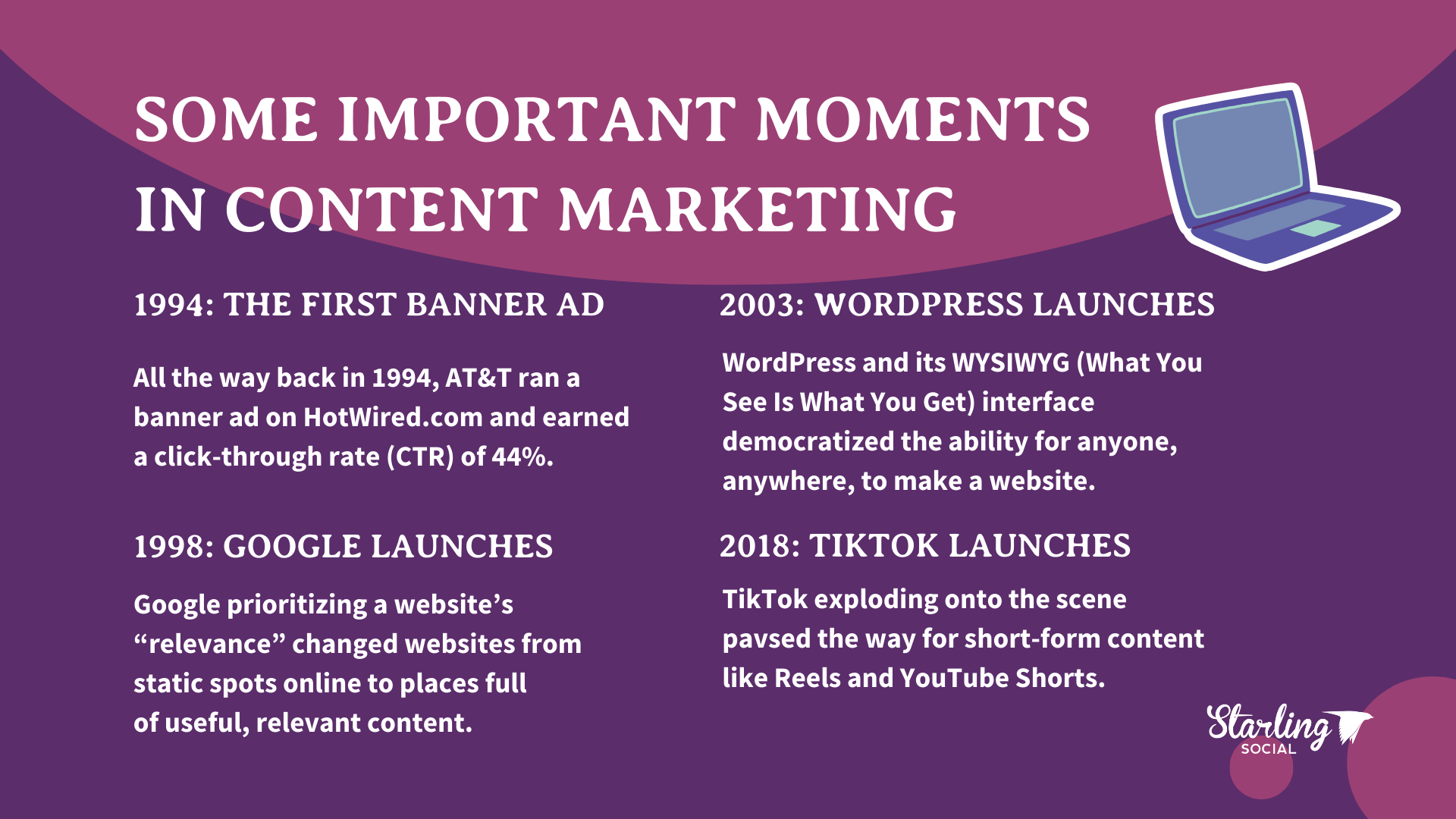
Types of Content Marketing
Blogging
Of course I had to start here, with the “OG” type of content marketing.
Blogs (like this one) are still among the most important types of content marketing for several reasons, including:
- Building trust in your brand. Being able to articulate what you know about your industry and educate people about it shows that you know what you’re an expert in your field.
- Increasing website traffic. Blogs are still an important part of your search engine optimization (SEO) strategy. Not just because you can include important keywords in your content, but also because blogs engage readers for longer periods of time than landing pages, which increases SEO value.
- Driving conversions and sales. When someone lands on your website and reads your blog, it helps them learn more about you and what you offer, which increases the likelihood that they’ll reach out.
- Increasing link-building efforts. Linking to authoritative sources in your blog content, like a product manufacturer, page that has data to back up your writing, or other “reputable” website helps improve your search engine ranking.
- Repurposing blogs for social media. You’ve probably noticed that we share 2-3 posts on average per blog post to our social feeds, not to mention when I promote them on my personal LinkedIn. This is a “bricks and feathers” approach to content marketing that works really well, and reduces the burden on you to constantly come up with unique content for every social media post.
But enough about blogs. Let’s explore some of the other types of content marketing you should be leaning into:
Video Content
Vidyard found that the average video retention rate for videos across the board is 54%, making this type of content one of the most impactful kinds you can create.
Video marketing is continuing to evolve, but some of the most popular types of videos you can create are:
- Instagram Reels
- Facebook Reels
- TikTok videos
- YouTube Shorts
- Livestreams
The possibilities here are really endless. You can create tutorials on YouTube; short, snappy TikToks and Reels with trending audio and sounds; and everything in-between.
One example I really like is Old Spice’s “The Man Your Man Could Smell Like” campaign that launched back in 2010. The videos featured actor Isaiah Mustafa (aka the "Old Spice Guy") in a variety of weird and silly situations speaking directly into the camera in an exaggerated way.
This campaign re-positioned Old Spice as a brand that didn’t just cater to older men, but was attractive to trendy, young people, too. The campaign was so successful that Old Spice’s sales skyrocketed by 107%.
Infographics
Humans have been creating infographics since the pre-internet period, but this type of content is especially useful at conveying information online since users’ attention spans sit at around 8.5 seconds.
While infographics can be effective, there are a few ground rules to keep in mind:
- Plan your infographic and use it to build on the narratives you’re already telling with your other content.
- Use headings and subheadings to increase “readability” and keep users engaged.
- Lean on tools like Canva, Piktochart, and others to easily create scroll-stopping graphics.
- Consider making infographic templates for yourself to make creating new ones fast and easy.
Podcasts
Like I said above, podcasts have been around for ages, but only recently have become one of the more popular ways for brands and marketers to get their message out there.
Podcasts can help you reach a wider engaged audience who are interested in your industry and expertise. Some of the ways you can use podcasts are:
- Interviewing guests, experts, and influencers.
- Sharing insights on trends, news, and spicy topics.
- Increasing your visibility through platforms like Apotify, Apple Podcasts, and Google Podcasts.
- Build a loyal and active community around your brand.
Protip: If you don’t have time to host your own podcast, look for podcasts in your niche and pitch them on being a guest on the show. I do this all the time and get a lot of traction and awareness about Starling Social from my interviews!
Memes
If you follow us on social media, you know we love a good meme.
Memes are a form of cultural expression that spread through variation and imitation, and can be images, videos, text, music… you name it, these days it’s probably meme-able.
Memes are effective forms of content marketing for the following reasons:
- They showcase your brand personality, voice, and sense of humour.
- They relate to your audience and their challenges and pain points.
- They engage with your audience and encourage them to like, comment, and share your posts.
- They show you’re “tapped in” to current cultural trends and have your finger on the pulse enough to create entertaining, relevant, and engaging content.
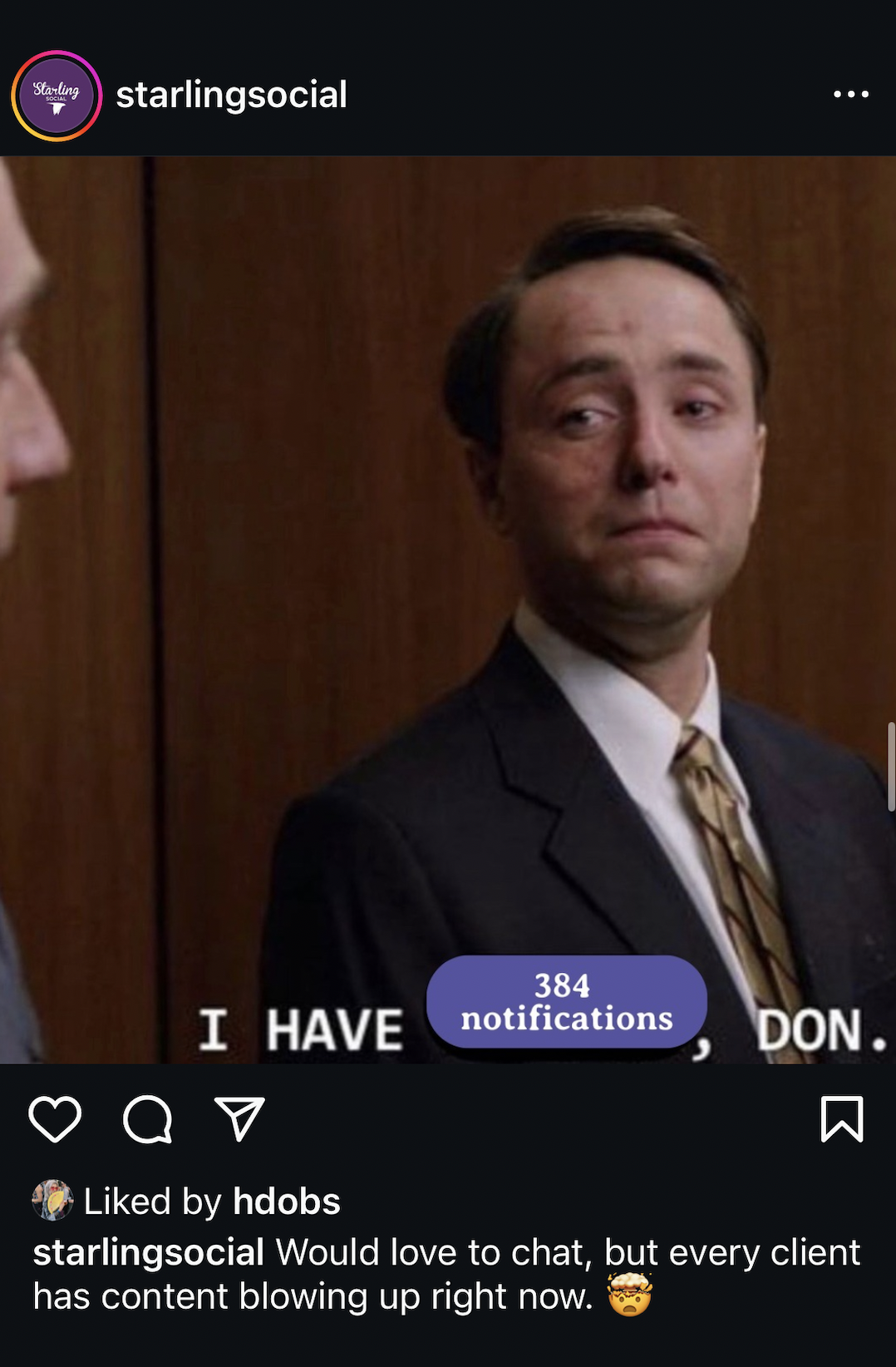 | 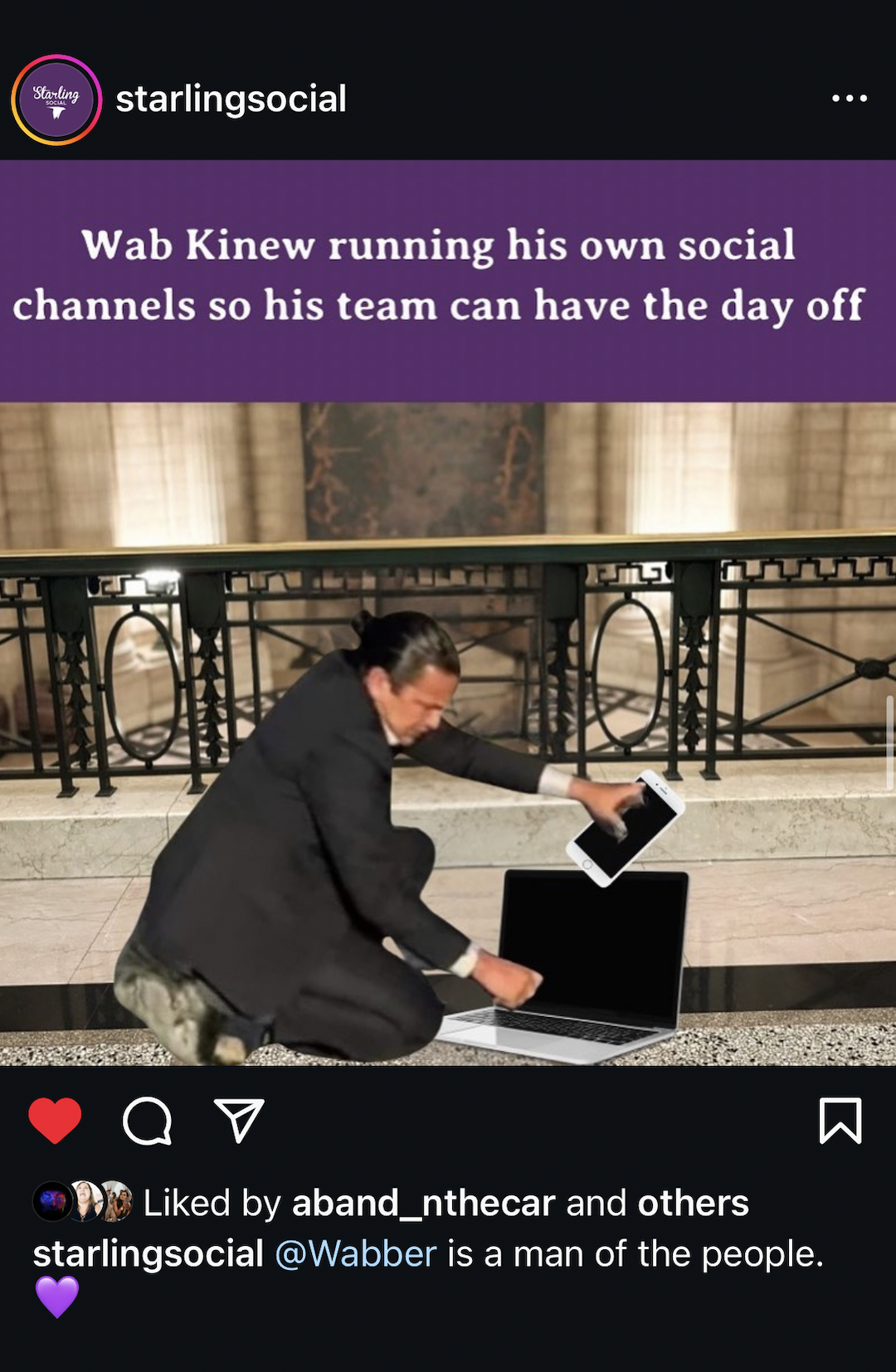 | 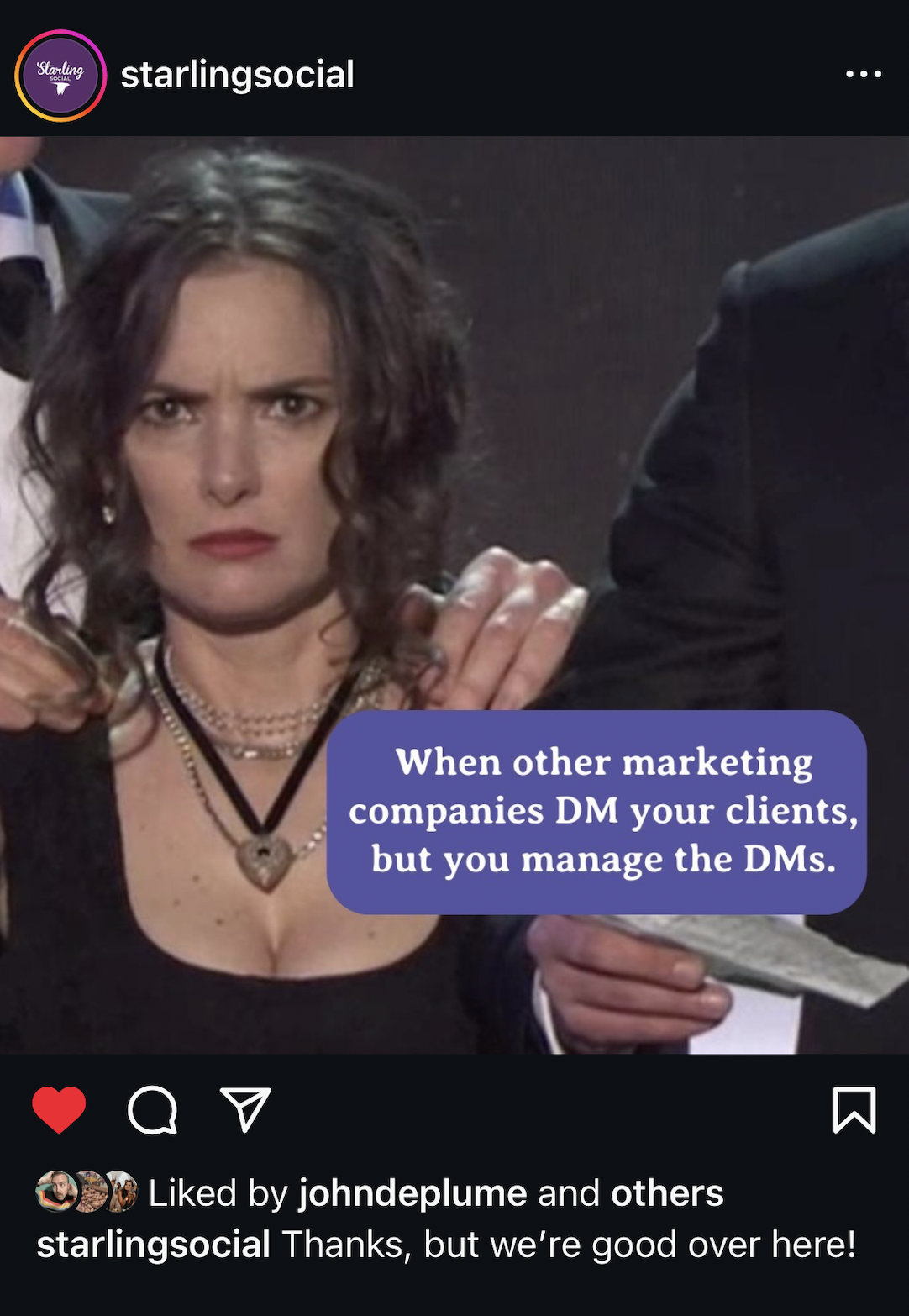 |
Webinars
Webinars are a great way to generate brand awareness because they position you as a subject matter expert and give you a platform to educate and empower your audience.
They also reinforce you as a subject matter expert who can easily talk about specific topics, ideas, or strategies related to your industry.
Because webinars are delivered digitally, they also allow you to reach a broader online audience of people who might not have heard about you otherwise.
You can host your own, or partner with other brands and organizations to develop and deliver your webinars to a specific audience. For example, I’ve delivered dozens of webinars as a facilitator with Volunteer Manitoba since 2017, which has allowed me to connect with nonprofit organizations in my community who I might not have been able to reach otherwise.
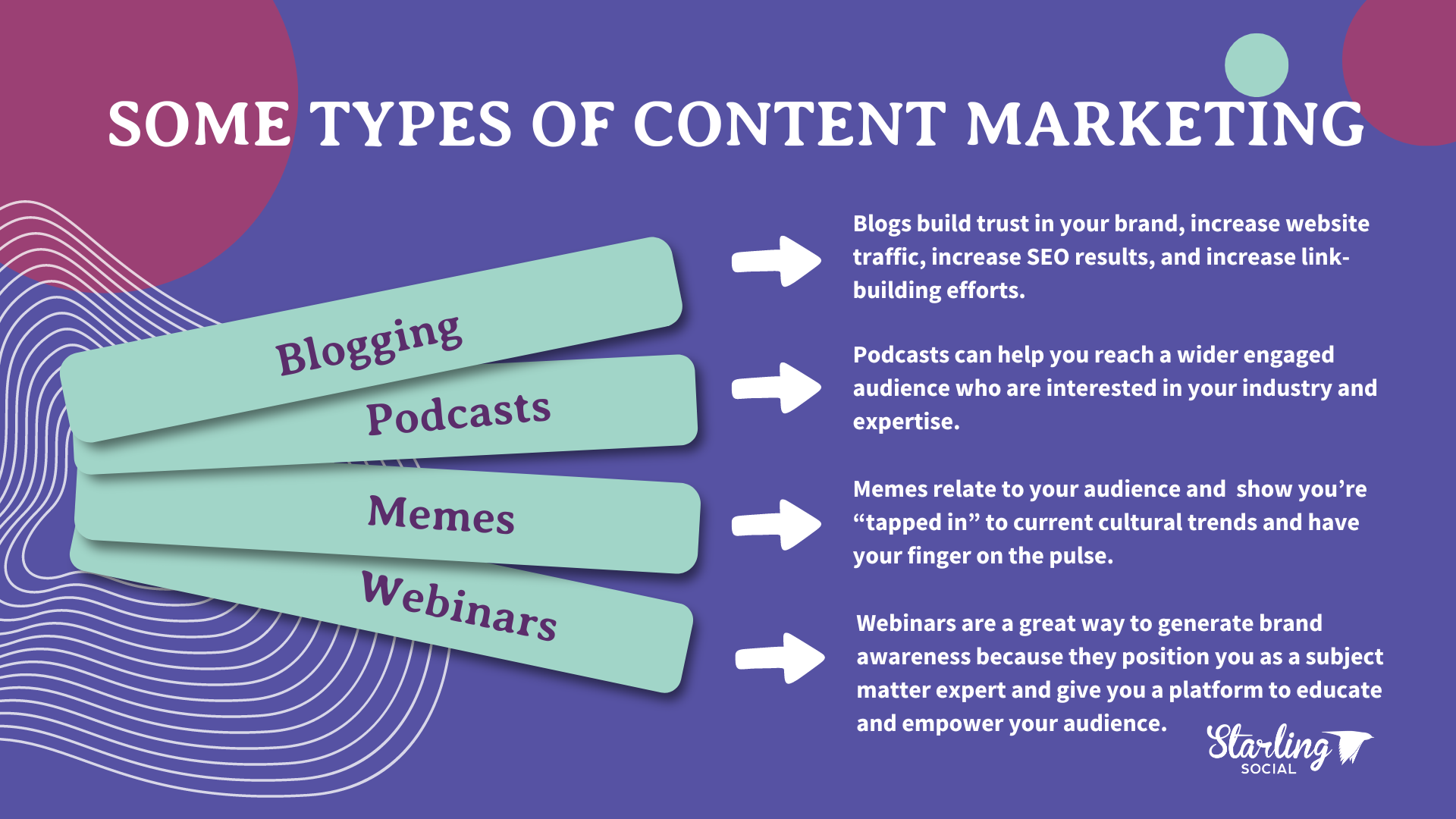
eBooks
Before you clutch your pearls at the thought of writing a whole book, think of it as long-form blog content instead.
eBooks aren’t novels; they’re multi-page ads for your business that reinforce you as a subject matter expert and empower potential clients and customers with information that builds trust.
One great example is The Experience Optimization Playbook by Optimizely, which explores optimization strategies from Fortune 500 companies.
Case Studies and Whitepapers
Case studies can be time-consuming to create, but are a great way to tell a story about how your product or service helped your customers achieve a specific outcome or goal.
With this type of content, your audience can see a customer’s journey from start to finish and see similar use cases in real life.
A great example from LinkedIn shows how HSBC used LinkedIn’s marketing tools helped them diverse the way their marketing content is presented:
While whitepapers and eBooks are both examples of long-form content, they’re not the same thing.
Whitepapers are more densely-packed with information and data than most eBooks, and are detail-oriented where eBooks are more high-level.
User-Generated Content (UGC)
UGC is one of the easiest ways to gather content that tells a positive story about your brand, your products and services, and how they help real-life people.
People respond more positively when they hear stories told from people like them and can turn viewers into customers much more quickly than a lot of other content types out there.
One example of UGC I really like is from Doritos. They launched a site called Doritos Legion of Creators where users can create branded images and videos that Doritos shares on their social media accounts.
Users have come up with all sorts of content, from snack-centric weather forecasts, to pictures of themselves laying back in piles of nachos, and more. The company keeps creators engaged by creating challenges like the “oddly satisfying challenge” which invites creators to create oddly satisfying videos for the chance to be featured on their Instagram Stories.
Testimonials + Reviews
Like UGC, testimonials and review-based content are generated straight from your audience and their experiences with your products and services.
This type of content is especially impactful if your business is operating in a niche market, because testimonials can act as overviews of what sets you apart from the competition.
You can see examples of how bigger companies like Nike use them, too; their Instagram feed is pretty much all celebrity endorsements and reviews.
Grow Your Business with Content Marketing
Content marketing doesn’t just drive immediate results; it’s a long-term investment in your company’s future and brand awareness goals.
By creating relevant, valuable, and high-quality content, you can attract new customers to your business and keep them coming back for years to come - and the best part is that you don’t need a huge marketing budget or team to do it!
Video Marketing in 2024: The Ultimate Guide
- by Alyson Shane
By Starling Social President, Alyson Shane
If you spend any time on social media then you’ve already witnessed the overwhelming amount of video content floating around - and it’s no surprise! According to Wyzowl, 94% of marketers consider it “essential” and 91% of businesses are always using it as part of their marketing strategy.
If you’re on the fence about getting into video, I get it: it can feel overwhelming at the start, but leaving this type of content out of your strategy will also leave you in the dust!
What is Video Marketing?
Video marketing is exactly what it sounds like: it’s using video content to promote your products, services, or your brand on social media, on your website, and through webinars and email campaigns.
Why is Video Marketing Important?
There are lots of reasons to include video in your marketing strategy! Here are a few:
Higher Social Media Engagement
A peer-reviewed study found that news articles that include videos get more engagement (likes, comments, and shares) on social media than those that just have photos.
User engagement is also an important way that algorithms on social media platforms rank what content is, and isn’t, worth showing to other users. So the more people that engage with your content, the more it’ll show it to users who don’t already follow you.
Videos stand out more on someone’s screen more than a static image does. Someone spending more time looking at your content is called “dwell time” and short, engaging videos are a great way to increase dwell time on your social media or website.
Research suggests that videos are also more likely to create an emotional response with the viewer, which encourages them to react to the video by commenting, liking, sharing, or sending the video to someone they know.
More Leads and Sales
Videos are a great way to get people to interact with your content, increasing the likelihood that they’ll turn from just viewers and into customers. According to Wyzowl, 87% of companies using video marketing said that they led to increased sales.
Ending your videos with a call-to-action (CTA) like “Click Here” or “Buy Now” encourages the person viewing the video to take the action you want them to take.
So you’ve already pulled them in with an interesting and engaging video, helped familiarize them with what you do and what you offer them, and you’re able to encourage them to convert. Win-win-win!
Better SEO Rankings
Embedding videos on important landing pages on your website has a twofold effect: first, some people don’t want to read copy and would prefer to watch a video, and second (and maybe more importantly) it causes people to stick around on the page longer, which improves your website’s search engine optimization (SEO) rank.
Videos also get picked up by search engines like Google, meaning you can get your message out in front of people who aren’t even visiting your site.
Better User Experience
Let’s face it: some people just prefer to consume content through videos. They don’t have to read huge walls of text and are able to sit back, watch, and listen as they follow along.
Specifically, videos like tutorials and product explainer videos are a great way to connect with your customers. For example, product explainers and service explainer videos break down how what you offer benefits them and explains how they work, setting you up to look like a helpful subject matter expert.
Improved Brand Recognition
Video content is like a sneaky shortcut to help familiarize someone with your brand.
Video is much better at evoking an emotional response in someone and can show off a fun and dynamic side of your brand, which is what sets you apart from similar companies.
Strong branding = increased sales, so this is a great approach.
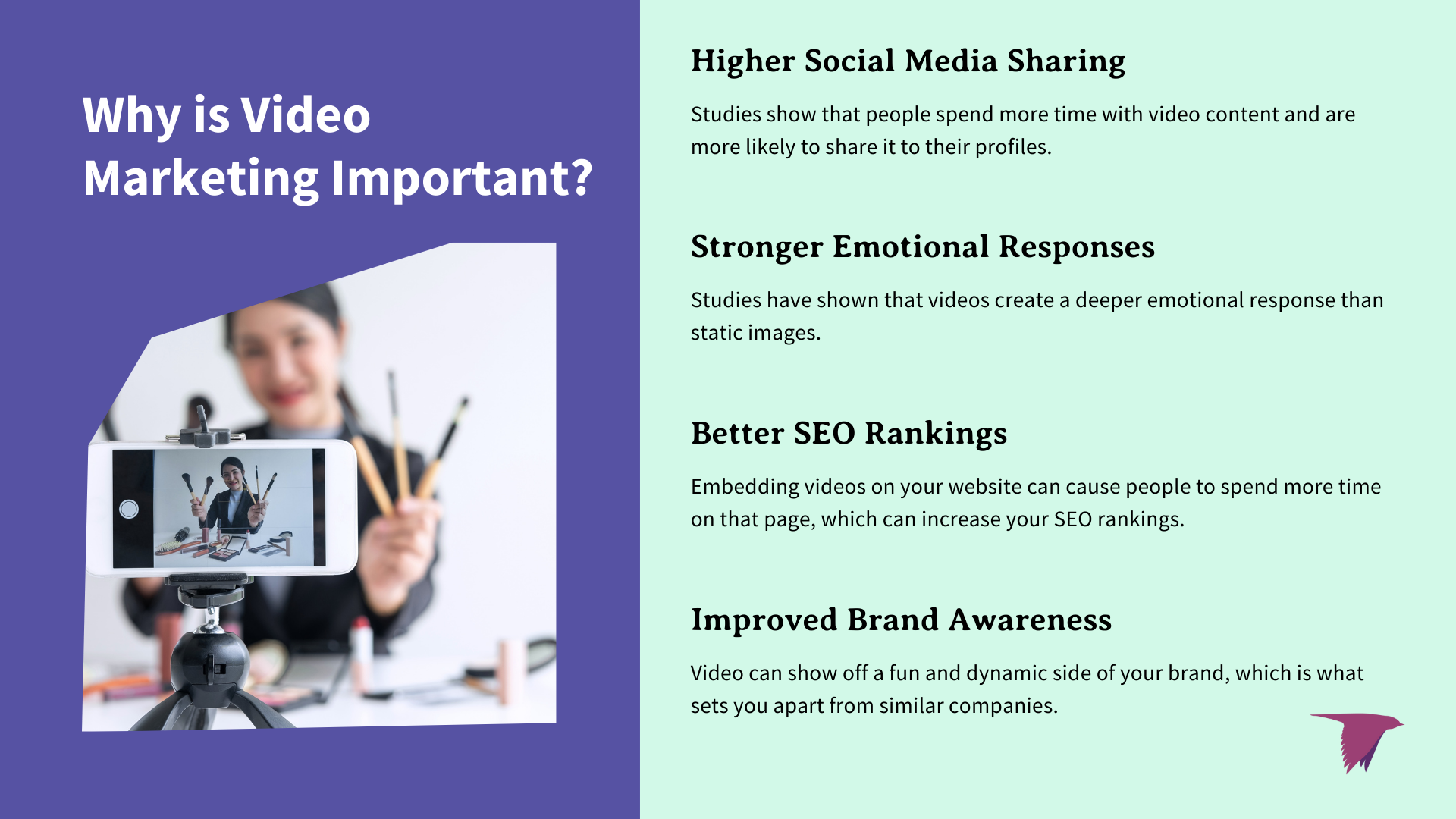
Types of Video Marketing
There are lots of kinds of videos you can make to connect with your audience, including:
Explainer Videos
Explainer videos are educational tools that break down points of interest or product features to the viewer.
These are not sales tools — they’re ways of educating and empowering the viewer and showing them how what you offer can benefit them. So while you should include a CTA at the end of every video, make sure to focus on what the viewer needs to know instead of trying to sell at them.
Product Demos
Demo videos are deep-dives into how a specific product works. Usually they show someone using it in real-time and showing off its features and functionality.
Customer Testimonials
We love testimonials! This type of video showcases a real-life person who has used your product or benefitted from a service you offer.
This is referred to as “social proof” because it’s not coming from you or someone else involved with your business or organization; this is a “regular” consumer who loves what you offer enough to sit down and talk about it.
They’ll share their experiences, talk about what made the product or service so great, and (ideally) inspire others to try it out for themselves.
How-To Videos
This video type is exactly what it sounds like: they show the viewer how to do something.
The internet is littered with how-to videos for pretty much every product or technique out there, from makeup how-to’s to DIY renovation projects, so in addition to shooting some of these yourself, a great way to make the most of this video type is to reach out to influencers and content creators in your niche and pitch them on partnering with you to do a how-to video using your product.
Livestreaming
We’re all probably familiar with the concept of a livestream by now, but as a refresher, this style of video is… streamed live.
Livestreaming is a great way to show the raw, unfiltered side of your brand and to help establish trust and credibility with your viewers because what they see is what they get.
You can livestream on Instagram/Facebook, YouTube, and TikTok, but just make sure to promote your livestream in advance so people know when to tune in!
Event Videos
These videos capture key moments from an event you’re hosted or attended, and can be a great way to show how your brand engages with the community. This video type offers a behind-the-scenes peek into your company culture and creates a more personal connection with your audience.
Another benefit to this video type is that they can get attention from people who weren’t able to attend and might want to show up in the future.
Animated Videos
Animated videos are a great way to break down complicated concepts and can be used for a variety of things, from explaining products and services, to creating engaging content that isn’t just a “talking head” on a screen, as well as showing how different processes work.
User-Generated Content (UGC)
UGC is content created by other users who aren’t directly connected to your brand, like reviews, testimonials, or videos of themselves using the products you sell. This type of video is great for conveying authenticity and credibility about what you offer.
Like I said above: connecting with influencers can be a great way to create this kind of content, but encouraging your customers more generally to create UGC you can re-share. Some CTAs you can use in your marketing to encourage this type of content can look like:
- “Show us how you’re using [product]”
- “Send us a video showing your favourite way to use [product]”
- “How do YOU use [insert product]? Send us a video and we’ll reshare it!”
How to Make High-Quality Video Content
Gone are the days when “potato quality” videos were acceptable. Here are a few tips to create scroll-stopping videos:
Define Your Objectives in Advance
Firstly, decide what your goals are with your video content. Are you looking to increase brand awareness, educate your audience, drive sales…?
Whatever your objective(s), your video content should work towards these goals.
Next you’ll want to identify your target audience. Some things to ask yourself include:
- Who are you making these videos for?
- Where are they on their buyer’s journey?
- What kinds of videos do they want to see?
Once you’ve defined these areas, you’ll want to set goals for yourself in terms of the amount of content you’ll create (be aggressive, but realistic) and which metrics you’ll track to understand which videos are helping you achieve your goals, like video views, engagement, click-through rates (CTRs) and conversions.
Build Your Video Marketing Strategy
Using the research you just did, look into the social media platforms where your ideal customers are spending their time. There are lots of things that might play into this, but one of the key elements is their age. Here’s a quick breakdown of age demographics and platform usage from Sprout Social to make ti a bit easier:
- 18-29 years – Snapchat (41%), TikTok (35%), Instagram (32%)
- 30-39 years – LinkedIn (34%), X/Twitter (34%), Snapchat (33%), Instagram (32%)
- 40-49 years – LinkedIn (25%), Facebook (22%), X/Twitter (21%)
- 50-59 years – Facebook (29%), LinkedIn (24%), Pinterest (24%)
Another thing to consider is a “bricks and feathers” approach to your video content. I dug into this concept in this blog post, so don’t miss it.
Plan and Write Your Script
I can’t emphasize this enough! Without a script you’re likely to sound unprepared, and will probably pepper your videos with lots of “umms” which can detract from your message.
Here are the steps I use when creating video content:
- Outline the script. I like to get as granular as possible with this and will literally write out exactly what I want to say, in large text (so I can read it on my screen) and line breaks where I want to “cut” the video.
- Be conversational. Act like a real human and speak the way you would as if you were talking to someone face-to-face. If you have to use technical terms or jargon, make a point to explain it in the video, too.
- Use a hook. “Hooks” are a statement that tells the viewer what they can expect from the video, so include one as the first or second thing you say in your video.
- Include a call-to-action (CTA). Like I said above, tell people what you want them to do after they’ve finished viewing the video.
- Include visual direction. Don’t just sit in front of your screen like a talking head. Use your hands, show emotion and excitement through your facial expressions, lean in and out for emphasis, and use graphics when appropriate.
- Be mindful of your video lengths. Different social platforms have time limits for videos, so look this up in advance so you don’t accidentally shoot something that’s too long. Here’s a reference for that.
- Practice! If you’re new to creating videos, you might need to run through your script a few times before filming, and that’s okay! Practice makes perfect.
Shoot and Edit
These days a high-end smartphone is often more than enough to shoot a decent-quality video.
Use natural light when possible along with a ring light to even out the light in your space. If you’re using a ring light it will typically come with a tripod, so make sure to use this as well so your video isn’t a shaky mess.
Once you’ve captured your footage you can either use a video editing tool (I use iMovie because I’m on iOS for my horizontal videos) or use in-app editing tools which can be found on platforms like Instagram and TikTok.
Include Captions
Captions serve several important purposes:
- Increasing accessibility for people who might have issues hearing your videos.
- Encouraging viewing since lots of people scroll through social media with their volume turned down or off completely.
- Increasing your social media search engine optimization (SEO) since social media algorithms crawl and index videos based on the text in the captions.
Choose an Engaging Thumbnail
Thumbnails are the still image of your video that shows up on users’ timelines before they start viewing the video.
For platforms like YouTube that don’t auto-play videos, you’ll want to use a tool like Canva to create an attention-grabbing thumbnail, but for platforms like Instagram and TikTok you can usually get away with choosing a still from the video you’re uploading to use.
Incorporate Branding Elements
Reinforce your brand identity by including things like logos, colour schemes, or taglines that draw a stronger link between your video and your brand overall.
If this feels too heavy-handed or technical, choose a spot in your office or home (if you work from home) that has interesting elements that can become familiar to viewers when they see your videos pop up on their timelines.
Publish and Promote
Once you’ve published your video you need to do a little leg work to get it out into the world.
Include relevant keywords in your title, captions, description so your content can be found by people who are searching for it. Make sure to re-share it to your Instagram/Facebook and TikTok Stories with a sticker linking the viewer to a relevant page on your website.
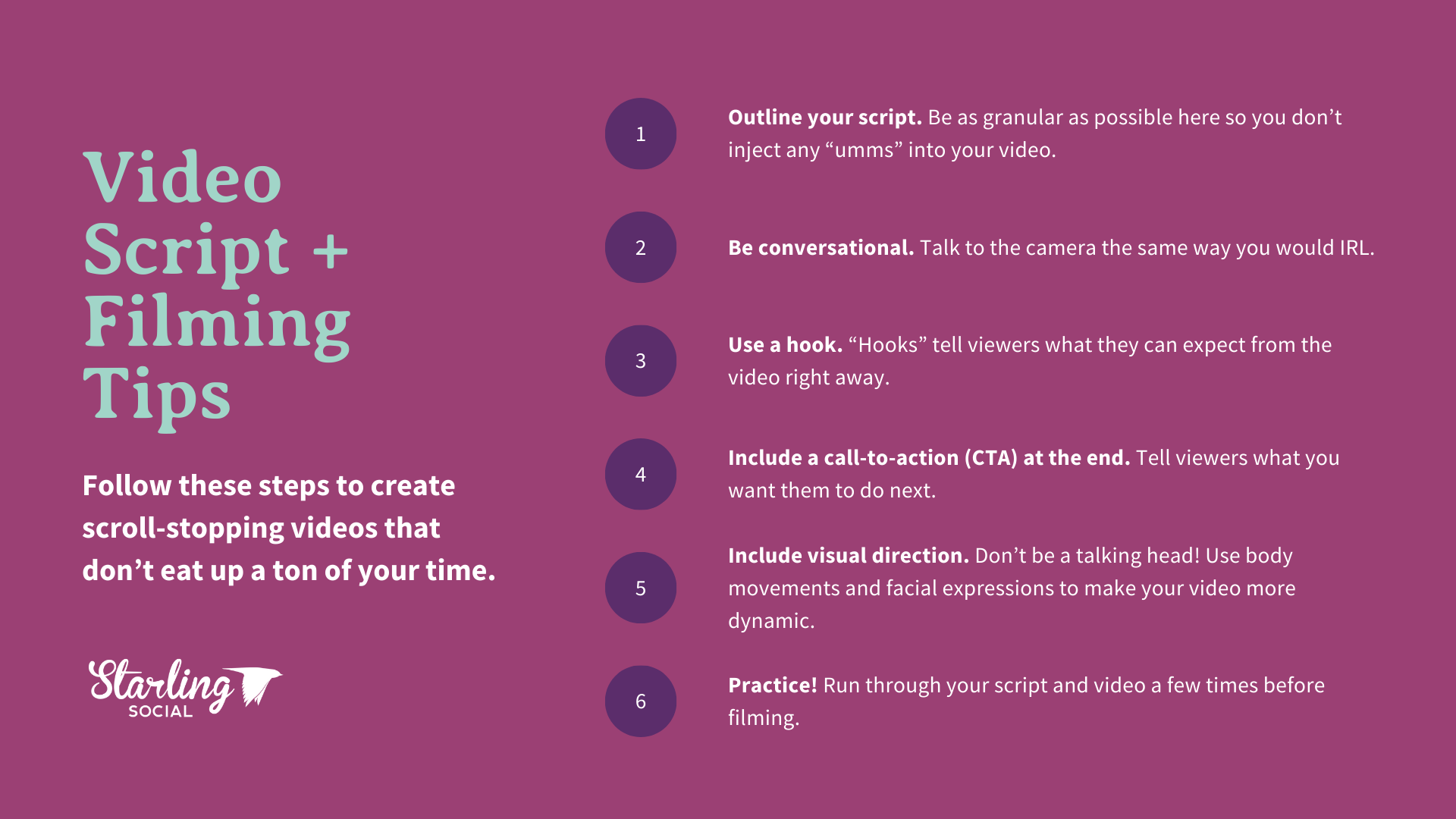
Video Best Practices
Before we wrap up, let’s review some “best practices” for your video content:
- Keep it short. The best videos are concise and to-the-point. Decide what the single focus of your video will be and stick to one topic.
- Stick to your core message. Choose what the message of your video will be and don’t deviate from it.
- Tell a story. Have a beginning (hook), middle (demo, explanation, testimonial, etc.), and an end (CTA).
- Add captions. Increase accessibility and boost your SEO so more users can find your video.
- Include a CTA at the end. I’ve probably beaten this point to death, but every video should have a call-to-action (CTA) at the end.
Get Started With Video Marketing Today
Video is here to stay, so if you haven’t taken the plunge then there’s no better time to dive right in and start creating entertaining, engaging, and informative content that highlights the value of your products and services.
Still feel like you’re struggling with your video marketing strategy? Just click here and connect with a team of content marketing professionals (hint, that’s us!)
The Impact of AI on Digital Marketing Strategies
- by Alyson Shane
Lately it seems like artificial intelligence (AI) is everywhere. Whether it’s “imagining” super weird-pictures, answering questions, or generating content, these days it feels like you can’t open an app or browser window without running into an AI tool.
Before we dive into this topic I want to be clear: the current state of AI is not a replacement for human effort and output — but that doesn’t mean that we haven’t been experimenting with it and testing various tools to see how they can help us deliver better results for our clients when possible.
Here are some ways the Starling Social team and I are seeing AI’s impact on the world of digital marketing:
Personalized Customer Experiences
AI-powered algorithms can learn a lot about us in a frighteningly short amount of time by analyzing things like our browser behaviour, buying history, and other preferences to deliver highly personalized content and recommendations.
By using AI, businesses can offer targeted product suggestions, customized offers, and even tailor communication strategies to encourage higher engagement rates and conversions.
We’re also seeing a rise in AI-powered chatbots that go beyond your typical canned responses — these tools can understand context and provide personalized assistance for users who need it.
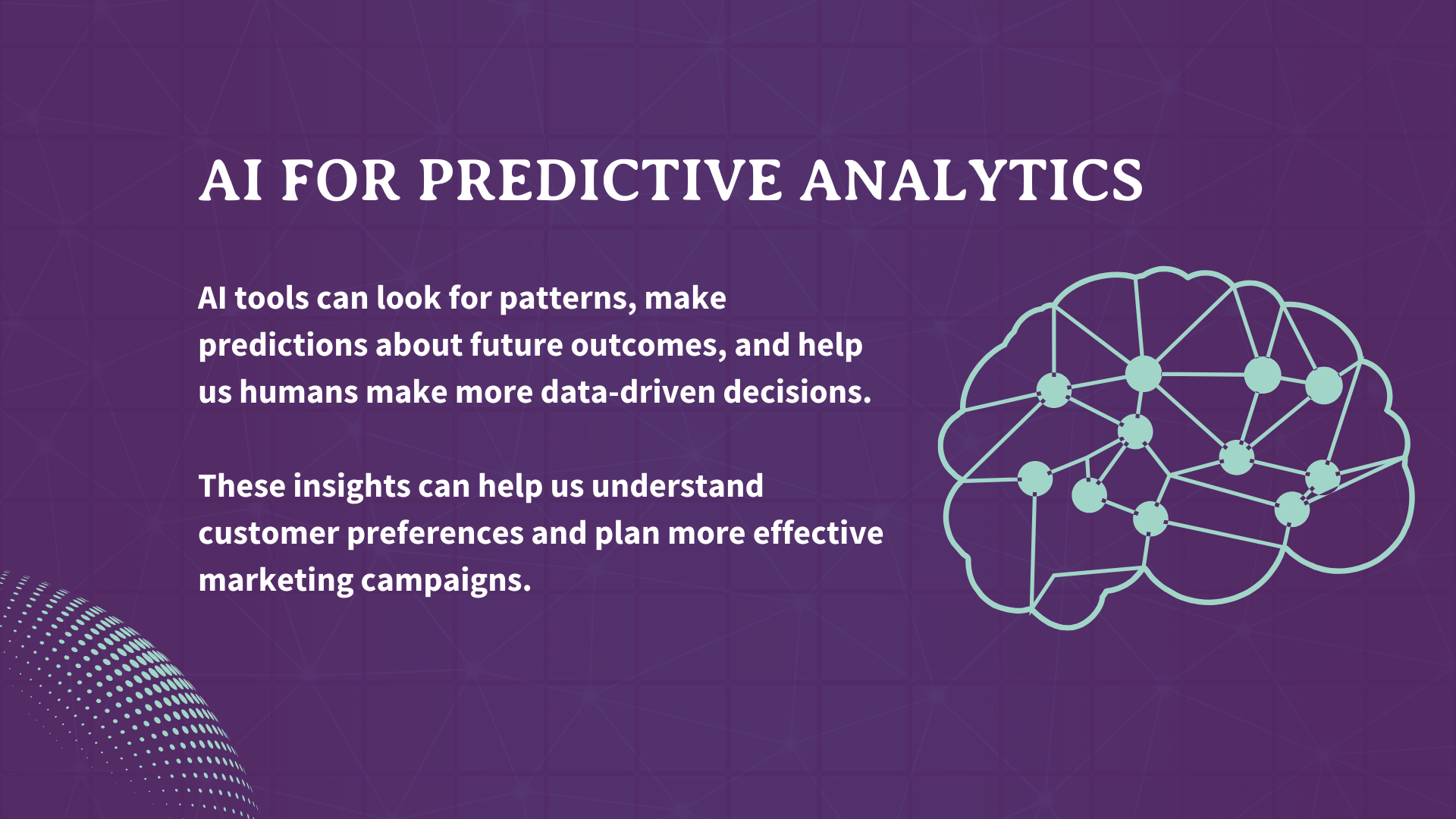
Predictive Analytics
Here’s an area where we’ve been seeing a lot of positive use cases for AI tools!
Since AI can quickly analyze huge amounts of data, businesses can use it to look for trends in consumer behaviour and in the market more broadly.
AI tools can look for patterns, make predictions about future outcomes, and help us humans make more data-driven decisions.
These insights can help us understand customer preferences and plan more effective marketing campaigns.
Automation in Marketing Campaigns
AI tools can help with strategic decision-making when it comes to managing the mundane parts of a marketing campaign.
AI-powered tools can analyze past user behaviour and figure out things like the best time to schedule a social media post, to scheduling emails at times when readers are most likely to open them, and even when someone should see your ads (more on that below).
Improving Productivity
Recently I was on a Zoom call with another agency owner who mentioned that they were using a tool called FireFlies AI during our meeting.
This cool AI tool not only emails meeting participants a transcription of the meeting but also puts together a handy summary of the meeting as well. Check it out:
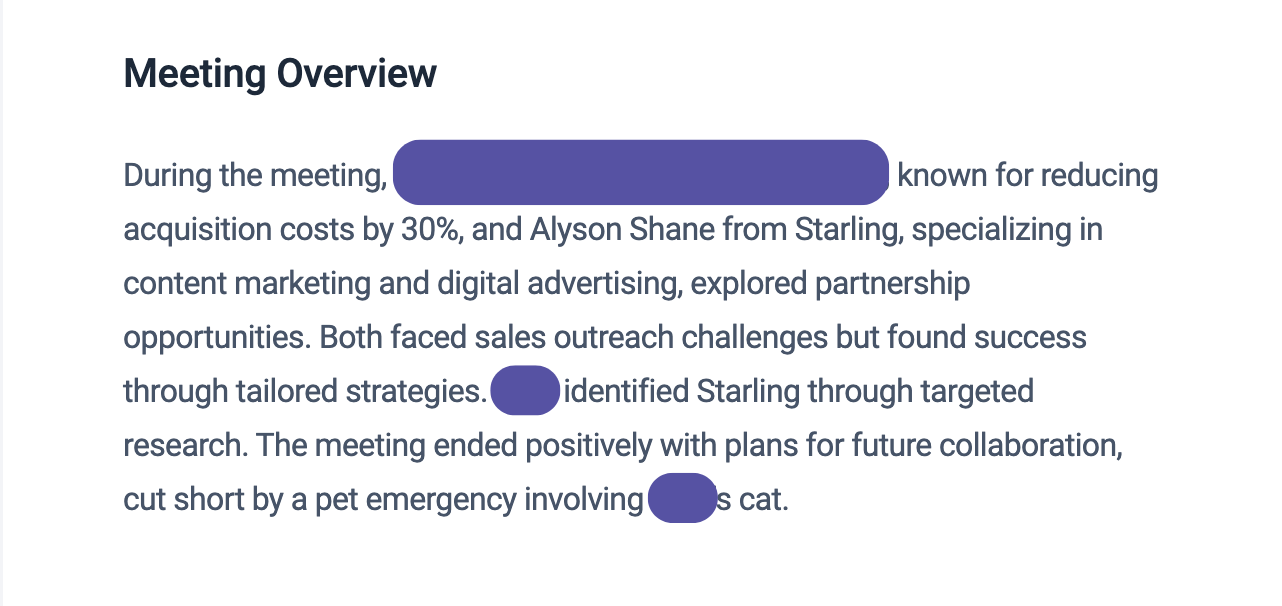
Content Creation
If you follow us at all then you know we have thoughts about this — and they aren’t positive.
Basically, the current generation of AI isn’t able to replicate the kind of high-quality content that humans are able to write and think up.
If you don’t live and breathe this industry, then you’ve probably read AI-generated content and not been able to tell the difference, but I studied rhetoric (persuasive writing) and have been publishing content online for 22 years, and believe me, once you start seeing the patterns in AI-generated content it becomes infuriatingly bad.
Everything starts to sound same-y, repetitive, and clunky. Often tools like ChatGPT and others will use language that doesn’t “sound” like the way people regularly speak.
To those of us who live and breathe this industry, AI-generated content sounds like nails on a chalkboard.
As it stands, we don’t recommend using AI tools for your business and content needs.
How to Spot AI-Generated Content
Let’s take a second to cover some patterns to look for in AI-generated content so you can start to understand how badly the current state of AI is “flattening” content online:
Objectivity
AI loves to add subjective claims to the copy it generates, so keep an eye out for copy that gushes about why something is important, relevant, or timely to the reader.
When reading copy, ask what in the following text supports a statement that something is:
- Impressive
- Thought-provoking
- Unique
- Noteworthy
- Remarkable
- Comprehensive
- Holistic
- Impactful
If there aren’t concrete examples, like explaining why something is “unique” compared to something else, then it probably wasn’t written by a human.
Passive Voice vs. Active Voice
The most effective copy is written in an active voice, but AI tends to write in a passive voice which can be a dead giveaway. Here’s an example of what I mean:
- Passive voice: The project was led by our CEO, Steve.
- Active voice: Our CEO Steve led the project.
Active voice in writing is more impactful, uses shorter sentences, and tends to be clearer — something the current generation of AI isn’t great at, yet.
Logical Correlations
Keep an eye out for phrases like “as evidenced by” because typically if AI is generating the copy, the first part of the statement won’t be supported by objective evidence.
Structural Clichés
This is one of those things you can’t “unsee” once you start noticing it. Look for structural clichés like:
- In this fast paced world
- It is important to note that
- In the dynamic world of
- A treasure trove of
- Embark on a journey
You can find a longer list of overused AI generated phrases here.
Repetitiveness and Verbosity
When AI generates copy that says something like “the new process effected transformative change” it should actually be written as “the new process transformed X.”
This is one of my biggest pet peeves with AI-generated content; it’s super verbose and if you read it out loud, it doesn’t reflect how humans really speak.
Overusing Verbs
AI loves to lean on specific verbs because they’ve been overused in business for decades. This tends to make the copy sound clunky and tired. A few examples to look for include:
- Delve
- Foster
- Ensure
- Tapestry
- Transform
- Leverage
- Revolutionize
- Captivate
You can find a list of even more overused AI words here.
Improved Pay-Per-Click (PPC) Results
We’ve been experimenting with Google’s AI tools to enhance our clients’ PPC campaigns and seeing great results… sometimes.
We’ve been running small A/B tests instead of applying AI to the full campaigns, since sometimes the AI makes choices about targeting and keywords that aren’t related to our campaigns (not good!)
While AI has certainly enhanced the return on investment (ROI) of some of our campaigns, we definitely need to make sure we’re keeping an extra-close eye on the campaigns that are AI-powered since we often have to go in and tweak things to keep the tests running smoothly.
Advertising Targeting
Machine learning algorithms can analyze user demographics, behaviour, and interests and show highly targeted ads to people who are likely to be interested in what you offer.
In theory, this can help you reach more of your target audience, increase your ad relevance (showing ads to the right people at the right time), and can reduce ad spend across the board.
Note: we’ve been experimenting with Meta’s AI-powered targeting and have found that our humans-led targeting is outperforming AI-powered ads in all metrics. This may change, but right now we recommend a human-led approach to your targeting!
AI and Your Digital Marketing
There are lots of ways that AI is changing the world of digital marketing for the better, and some ways where it’s a substitute for corner-cutting.
This is likely to change as the tools continue to learn, iterate, and become more sophisticated, so it’s something that we’ll be keeping an eye on, and you should, too.
If you’re looking for high-quality, human-created content for your marketing plan, reach out today! You can also subscribe to our weekly newsletter for all the latest news, updates and strategies in the world of digital marketing.
How to Use LinkedIn to Grow Your Personal Brand and Scale Your B2B Company
- by Alyson Shane
By Starling Social President, Alyson Shane
The key to success in business is trust. After all, people want to work with, and buy from, people who they know, like and trust - and LinkedIn is the best platform for business-to-business (B2B) brands to reinforce those connections.
LinkedIn is also the best place for the people who run B2B businesses to grow their personal brands and reinforce their values and showcase the work they do to their communities.
In this post we’re going to be covering both of these topics: how to grow your personal brand, and scale up your B2B company, on this important and powerful platform.
Let’s start with the basics:
What’s a Personal Brand?
Let’s start with the basics: a “personal brand” is exactly what it sounds like!
Your “personal brand” is an extension of who you are. I love this description from Sprout Social that states: it’s the process of defining and promoting what you stand for as an individual.
When people think about you or speak about you, it’s your personal brand that they’re talking about, so it’s important to define what makes you, you.
Some questions you can ask yourself include:
- What are my values and how do I express them?
- What do I want to be known for?
- What’s my area of expertise and how can I share what I know?
- What makes me unique and sets me apart from others in my industry?
Once you’ve hammered out some answers to these questions, it’s time to start thinking about how to apply them to your LinkedIn presence.
How to Use LinkedIn to Grow Your Personal Brand
Let’s start with some actionable steps to level-up your personal brand on the platform:
1. Optimize your LinkedIn profile
Your profile is often the first thing people see when they find you on the platform, so this is an important first step.
Basically, you want your profile to showcase who you are, what you do, and why people should connect with you at-a-glance.
Here are a few things to keep in mind:
- Use a square, professional picture. Make sure the image aspect ratio is 400 x 400 px (pixels) wide. It should clearly show your face and, ideally, not be a selfie.
- You also have the option to post a profile video, but these are limited to 30 seconds so make sure to make them count!
- Use your background image strategically. This is prime real estate, so something related to what you do, your business’ brand, or something similar is ideal here.
- A headline that showcases your skills, and what makes you unique. This is the first thing most people will see, so make it memorable if you can! Here’s an example of what mine looks like:

- Hashtags that mention what you do. These are debatable (I don’t like using them, personally) but experiment and see what works for you!
- Links to relevant works in the Featured section. This could be places you’ve been published, your own published work (I do this a lot) or your resume, if you’re looking for work.
- Make the most of your “About” section. Spend some time writing an engaging description of who you are and what you do. This area gives you the opportunity to dig into what’s in your headline, preemptively answer questions, and expand on the unique skills and experience you bring to the table. Here’s what mine looks like:

Protip: take your personal branding a step further by customizing your LinkedIn URL. This can help you stand out in search results for your name and looks more professional than the generic URL LinkedIn generates for you. Here’s what mine looks like:

See? Short, snappy, and highly personalized!
2. Build Your Network + Start Engaging
Once you’ve got your profile properly set up, it’s time to start making connections and growing your network. To get started, focus on sending connection invites to people like:
- Friends
- Current and former colleagues
- Old classmates
- Industry leaders you respect
- Vendors you’ve worked with
- Other professionals in your city and network
That being said, when connecting with people on LinkedIn, there are some “best practices” to keep in mind:
- Personalize your connection request. You don’t have to do this, but taking an extra minute or two to write a short message explaining why you want to connect helps “humanize” your request and can make it look less spammy.
- Start with people you already know. Before you start trying to connect with friends-of-friends, focus on building a strong network of people you already know, like, trust, and respect. Then you can move onto making broader connections with other people in their networks and your industry.
- Join relevant LinkedIn groups. If you’re looking to connect with other people in your industry and “tap into” expertise on the platform, then Groups are the way to go. There are a few “ground rules” to follow, however:
- Spend some time in the group before engaging. This will help you know if it’s the right fit for your goals, and help you avoid looking like you joined the group just to spam everyone.
- Share relevant content and post useful, helpful comments. Remember: you’re not in a group to sell; you’re there to learn and be part of a community.
- Do not go heavy-handed on promoting yourself. Groups are communities of like-minded people and over-promoting yourself can come across the wrong way.
- Engage with your connections. This is a no-brainer; spend time on the platform every day (Monday - Friday, anyway) leaving thoughtful, supportive, and insightful comments. Over time, others will see the way you interact and hopefully want to connect with you, too.
Important: Never Lead With a Personal Ask or Pitch
I mean it. Don’t do this in a comment, or in a DM, or anywhere.
Leading with an “ask” or a pitch feels slimy, because it is. It shows that you don’t actually value the person or the connection; all you’re out for is to benefit yourself, and that rubs people the wrong way and can sour the relationship from the get-go.
If you want to work with someone or pitch them on a service, you need to spend time getting to know them first and, eventually, message them and focus on how you can provide value for them.
3. Start Creating and Sharing Content
Now comes the fun part: creating content to share with your connections!
LinkedIn offers lots of ways to showcase what you know and highlight what you do, including single-image posts, carousels, videos, and even newsletters.
Regularly sharing content on LinkedIn reinforces you as a subject matter expert, and helps you build a reputation as a go-to source for insights and information about your industry. The more you publish, the more credibility you can build for your personal brand.
Of course, if you’re new to the platform then this is easier said than done. Here are a few topics to consider to help you get started:
Identify the Framework of Your Personal Brand
Let’s start with the basics. Consider things like:
- What do you want to accomplish with your personal brand?
- Which types of connections do you want to reach?
- Which topics are you passionate about?
- What’s your personal backstory?
Be as specific as possible in answering these questions, since they’ll provide the foundation for your personal brand.
For reference, here’s what the framework for my personal brand looks like:
My mission is to empower others by de-mystifying the complicated world of digital marketing and content strategy.
My target audience are marketers and business owners who are too busy (or overwhelmed) to keep up-to-date on the latest strategies, and who might be looking to outsource their digital marketing to a team of experts (aka, me and my team).
To help them reach their goals, the topics I talk about are:
- Industry news and updates
- Social media tips and strategies
- Content marketing insights
- Business leadership and company culture
Sharing these kinds of updates positions me as a thought leader in my industry, and an expert that they feel they can trust to turn to when they need the services Starling Social offers.
The next step is to build out your personal backstory.
Of course, everyone is different brings a unique blend of skills and perspectives to the table, so I can’t really dedicate what your backstory should look like, but some things to consider include:
- How you got to where you are
- Unique experiences that shaped who you are
- Hands-on education and learning you’ve received
- Achievements you’ve earned
- How these elements help you bring a fresh take and expertise to the table
Don’t stress about nailing this right from the get-go; it’s normal to work to refine these stories over time, and over the course of multiple posts!
How to Use LinkedIn to Scale Your B2B Company
Let’s get into the nitty-gritty! Now that we’ve covered how to establish a presence on LinkedIn, it’s time to take what we’ve learned and apply it to scaling your B2B (business-to-business) company on the platform.
First Off: Why Use LinkedIn for B2B Marketing?
There are several reasons why you should be investing your time promoting your B2B company on LinkedIn, including:
Brand Awareness
Just like your personal brand, LinkedIn is a great place to magnify your company’s visibility and improve people’s perceptions of you and the work you do.
4 out of 5 LinkedIn users are in decision-making roles, meaning that a strong presence here can help them learn about your work, successes, and generate high-level brand awareness that can lead to future opportunities.
Lead Generation
Lead gen math is easy math: more leads = more opportunities for sales, and LinkedIn’s search filters make it super easy to identify potential leads in your target audience and develop personalized outreach campaigns to get them through the door.
Traffic Generation
Driving Traffic
Whether you’re driving traffic back to your website, or keeping your followers within the LinkedIn ecosystem by directing them to articles you’ve published on the platform, maintaining an active presence on LinkedIn can help get those eyeballs on the material you’ve worked so hard on.
This is also true for generating traffic to landing pages for campaigns you’re running, new product or service offerings, and anything else you want to promote.
Thought Leadership
It’s important to position yourself as a subject matter expert, but don’t sleep on the chance to reinforce your business’ expertise, unique value proposition (UVP), and the skills you bring to the table.
If potential leads see your company sharing relevant, interesting, and thought-provoking content, it reinforces the narrative that you’re at the bleeding edge of your industry and can move more leads through the pipeline.
This goes beyond just publishing your own posts, too. Make sure that your B2B brand is also answering questions “as” your brand in groups and on other people’s posts, too.
Strategies for Scaling Your B2B Brand on LinkedIn
Besides organic (unpaid) posting and replying in the comments section, there are several things you can do to elevate your B2B brand on the platform. Let’s explore a few:
Lead Gen Forms
Lead gen forms are exactly what they sound like: they’re lead generation forms that you can use to collect data without a landing page and amplify your sales efforts by connecting with people who are interested enough in what you offer to fill out a form.
LinkedIn Ads
This tip probably comes as no surprise to anyone. If you have an optimized business profile and are already posting organic content on a regular basis, then ads are a great way to amplify your reach and connect with an even wider target audience.
Be aware that LinkedIn ads are the most expensive type of advertising, so it’s important to be prepared and have all your campaign details (budget, timeline, targeting, goals, etc.) hammered out in advance.
LinkedIn Ad Campaign Groups
A “campaign group” is also exactly what it sounds like: it refers to groups of LinkedIn ad campaigns that you can manage at scale.
This approach isn’t something that’s widely discussed (I don’t know a lot of marketers who know about this feature, to be honest) but by placing related campaigns in the same “campaign group” you can:
- Set objectives that apply to all campaigns in the group
- Set budgets and schedules that apply to all campaigns in the group
- Manage the status of every campaign in the group in one place
- Review and export campaign metrics from the campaigns in the group
If you plan to run lots of different ad campaigns at once, this “protip” will make your life a million times easier, trust me!
Optimizing Your Company Page
We actually published a longer article about this back in late 2023 which you can find here, but here are some of the most important takeaways:
Schedule Your Posts in Advance
We’re big advocates of “batching content”, which refers to the process of creating a “batch” of content at once, then pre-scheduling it so you don’t have any gaps in your content schedule.
LinkedIn has a built-in scheduler, or you can use tools like Buffer or Sprout Social if you prefer to use a 3rd party option.
Follow Company Pages “As” Your Page
You can Follow company pages from your personal profile (and I encourage it) but a power move to generate more brand awareness for your business is to make a point to follow them “as” your company page, too.
This tactic adds greater viability for your Company Page, specifically, and encourages the people who manage the other Company Pages to follow you back, too.
Invite Your Connections to Follow Your Page
This is another one of my favourite B2B brand awareness tactics. You can use your personal profile to send invites to your connections to encourage them to follow your Company Page.
While this is an effective tactic, there are some basic ground rules to follow to not come across as spammy (which we don’t want):
- Don’t invite people you just connected with. Wait until they know you a bit better before making the “ask” of them.
- Send personalized invites when appropriate. This isn’t a hard-and-fast rule, but a little context and a personalized note makes people feel important and not like you’re just spamming them with invites.
- Re-up your invites as they happen. LinkedIn allows you to send up to 250 requests per month, and while that might seem like a lot it’s actually easy to hit the limit if you’ve got lots of connections. Luckily, as people accept your connection requests you “get” those invites back and can re-issue them to more people in your network, allowing you to exceed the 250 invite limit if your follow requests are accepted throughout the month.
These are just a few tactics available to you! Like I said above, you can dig into more strategies in this post about LinkedIn Company Page features you need to be using.
Start Making the Most Out of LinkedIn Today
We’ve covered a whole lot in this piece (it’s +2400 words, whoops!) so I hope this gives you a strong jumping-off point to start getting active and promoting yourself and your B2B business on this powerful platform.
If you’re looking for more insights to level-up your digital marketing knowledge, subscribe to our weekly newsletter which is jam-packed with the latest news and strategies.
How to Take a "Bricks and Feathers" Approach to Your Content
- by Alyson Shane
Raise your hand if you’ve ever found yourself in this situation:
You’ve spent several hours putting together a piece of long-form content, but now you’re left trying to figure out how to get as much mileage out of that giant piece of content as possible.
Enter the concept of “bricks and feathers”, a handy way to think about getting the most out of the effort you put into your content marketing strategy.
Not only does this approach save time (so important!) but it also adds a cohesive element to your content across all your digital channels, from your blog, to social media, newsletter and more.
Today I’m going to be digging into this useful concept and discussing how your business can use it to your advantage, so let’s dive right in:
Why the “Brick and Feather” Strategy Works for Content Marketing
The “brick and feather” strategy works because it solves a lot of the pain points that marketers face, including:
Scalability: You only have so many hours in the day, and by adopting this approach you can get more mileage from the content you share.
Cadence: Using “feathers” from your “bricks” allows you to speed up your content cadence and fill in gaps in your content queue.
Message discipline: Everything you publish should meet your customers at a stage in their buyer’s journey, and this approach bakes in message discipline so your audience feels trust and familiarity with your content.
What are “Bricks and Feathers”?
I was first introduced to this concept while researching content strategies for a talk I gave at the Engage Digital Media Summit way back in 2018.
I was looking for a succinct way to sum up something that I’d learned through my hands-on experience running Starling Social that I could introduce to my audience and help them understand without taking up too much time in my talk.
Here’s a summary of what I shared on stage that day:

Bricks: A long-form piece of content that you spend a lot of time creating.
This could be a blog post, whitepaper, eBook, case study… you get the idea. If you spend more than a few hours on a signal piece of output, it counts as a brick.
Bricks are also pieces of content that take time to consume on your audience’s end, too. A good piece of long-form content helps move your prospects further down the sales funnel, can open up conversations, and positions you as a subject matter expert.
Bricks are also effective because they increase the search engine optimization (SEO) value of your website. Long-form content is more likely to be referenced and linked-to by other sources online, which helps drive traffic to your site.
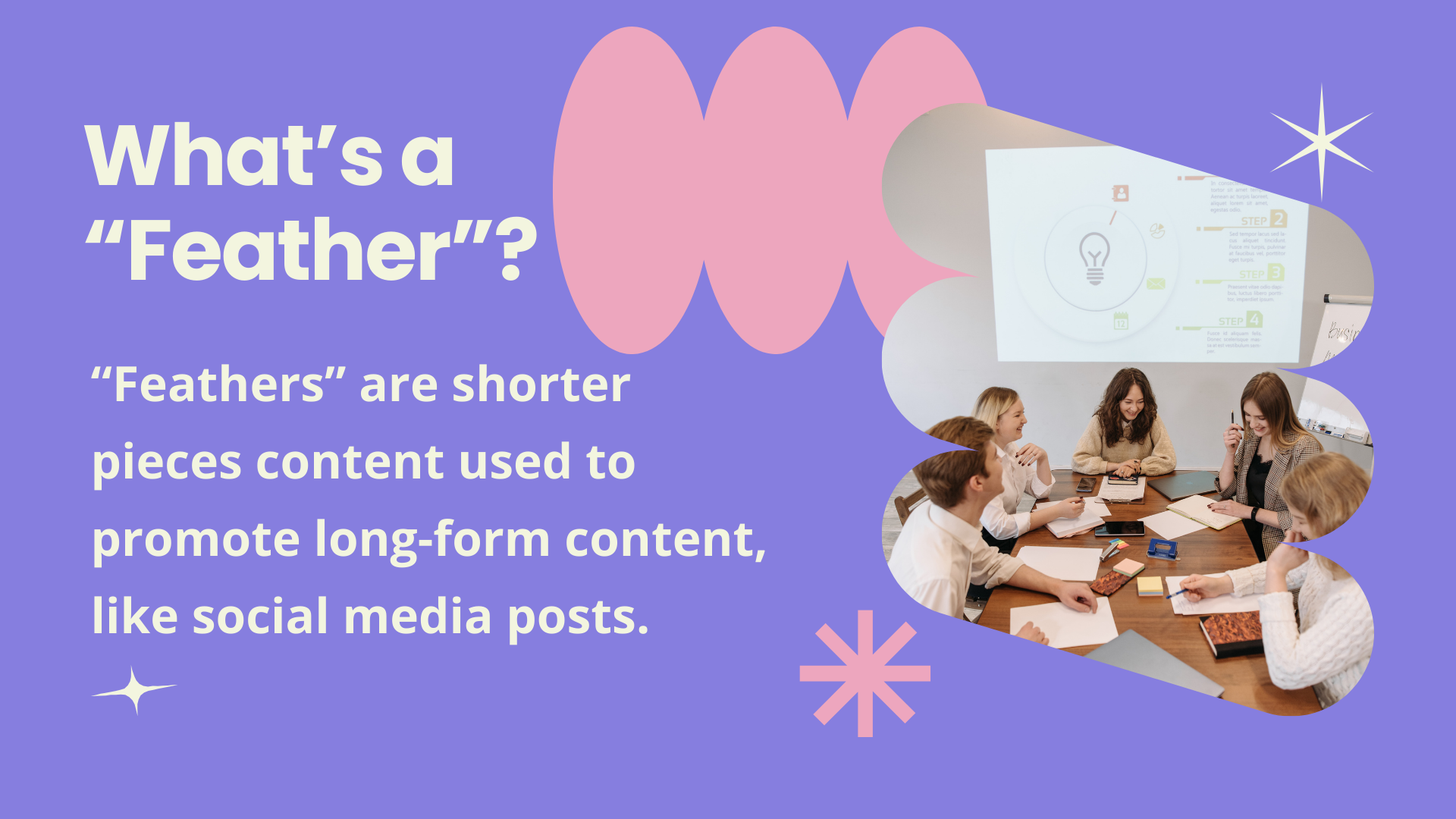
Feathers: Short-form content used to promote long-form content.
Once you have your “heavy” brick produced, it’s time to break it up into snackable chunks, aka your “feathers”.
Some examples of feathers include:
- Social media posts promoting the piece and sharing insights from the piece.
- Videos exploring key themes and acting as calls-to-action to read the whole thing.
- Statistics and visuals that sum up key parts of your content.
- Newsletters that share “snippets” of your content and link back to it on your site.
Each “brick” can be turned into multiple types of “feathers” and easily extended into weeks or even months of content!
Bricks and Feathers: The Best of Both Worlds
Using this approach to your content saves time, amplifies the ROI of your long-form content, and can keep potential customers coming back to your website over and over, eventually encouraging them to contact you.
If you want to chat more about how this strategy can work for your business, drop us a line!
Everything You Need to Know About The Current State of Threads
- by Alyson Shane
By Alyson Shane, President
Unless you’ve been living under a rock (and with the current state of social media, we don’t blame you), you’ve probably heard about Meta’s alternative social platform to Twitter/X: Threads.
As Twitter/X continues to hemorrhage users and lose public trust and confidence, Threads is moving in to replace the once-mighty microblogging platform and create a safer, more inclusive, and ultimately more positive space for people and brands alike.
Starling Social has been on Threads since the beginning (we actually left Twitter/X late last year) and several of our clients have been exploring opportunities on the platform, too, which is why I wanted to share an up-to-date deep dive on Threads so you can decide if a switch to the platform is right for you.
Let’s dive right in:
What is Threads?
Like I said above, Threads is Meta’s alternative to Twitter/X. It launched in July of 2023 and started out strong, amassing over 100 million subscribers within the first week.
Threads, like Twitter/X, is a “microblogging” platform, meaning that the content on the platform focuses on short, text-based updates vs. platforms like Instagram or TikTok which focus on images and video, primarily.
The platform was pretty bare-bones at the outset, but within a few weeks Meta had been rolling out updates since pretty much Day One.
With that in mind, let’s take a look at the most important features on the platform:
What Are the Most Important Threads Features?’
Meta’s been rolling out updates constantly since last July, meaning that there’s a lot to cover. With that in mind, I’ll be breaking it down into some high-level features, and digging into some in a more meaningful way because I think they matter most.
Trending Topics
Similar to other platforms, users on Threads can now explore “trending topics” that the algorithm (more on that below) thinks they might be interested in based on what they’ve posted.
“Trending topics” shows the number of active discussions on each topic, allowing users to stay up-to-date on trending discussions and join relevant conversations.
In January, app researcher Alessandro Paluzzi shared a screenshot showing that “Today’s Topics” appeared to be available.
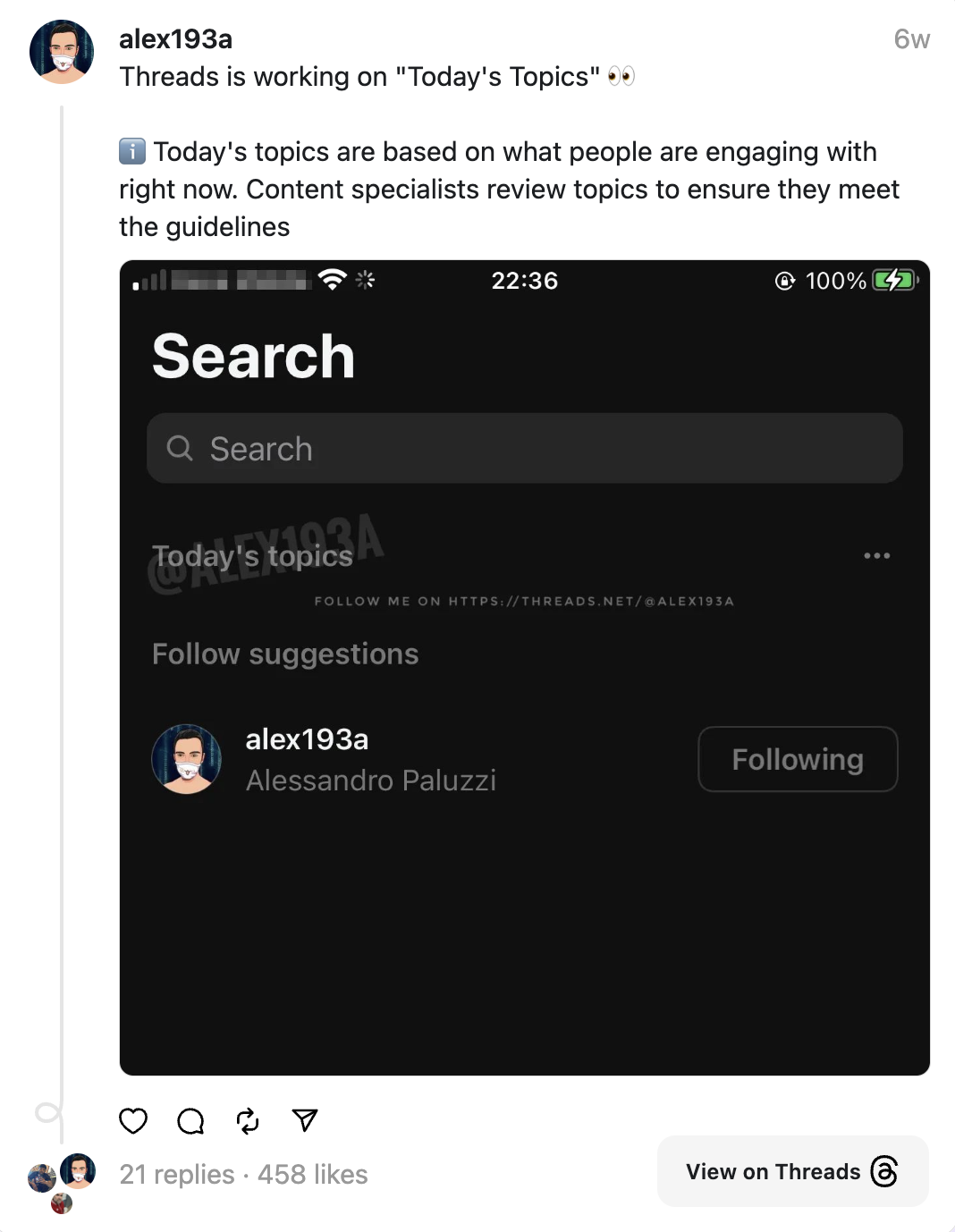
In mid-February Threads confirmed that they were currently testing the option with U.S. users, with the intention of rolling it out worldwide. This signals a strong intention to replace Twitter/X as the go-to- platforms for timely news and updates worldwide.
Voice Threads
Last fall Threads rolled out the “Voice Threads” feature, allowing users to create new voice threads, or reply to other people’s posts with a voice message. Once a user taps the microphone icon a voice recording and captions are automatically generated (and edited!)
This seems to be a nod to apps like the 2021 platform Clubhouse, but I’m not sure how popular this feature is turning out to be?
Anecdotally I’ve seen almost zero content published with just an audio recording, but that doesn’t mean that there won’t be opportunities to make use of this feature in the future.
Account Switching
If you work in digital marketing then you can appreciate what a huge deal this is. The update allows users to switch between multiple accounts without logging out and back in by clicking the icon in the top-right corner.
You can also add more profiles (perfect for social media managers), but the exact number of accounts seems to be a bit murky, so my recommendation is to start small and prioritize the most important accounts you need to manage, first.
Sorting Account Engagement
I love this feature! Under your “Activity” tab, you can sort how other users have engaged with your content to get a sense of what’s most popular and how your account is growing. You can drill down into several categories, including:
- All
- Follows
- Replies
- Mentions
- Quotes
- Reposts
- Verified (hows when a “verified” account has engaged with you)
Send Posts as Instagram Direct Messages
Direct Messaging (DMs) has been available on Threads since late last year, but if you want to share a Threads post to your Instagram profile, now you can do that, too!
This is a smart play in my view, since a lot of memes and “hot takes” that get shared across social platforms tended to come from Twitter/X previously (and still do, in some cases) — this ability means you can find something funny, entertaining, or interesting on Threads and share it easily without the need to grab a screenshot and manually upload it to another platform.
This also reinforces ties between Threads and Instagram, too, which should help more users start moving to the platform.
Keep Track of Your Likes
This is a common feature in other apps, too (Instagram also allows you to do this, but it’s more “hidden” in your profile).
In your profile, just click “Your Likes” to see all the Threads posts you’ve liked recently.
This is useful because one of the common complaints about social media platforms that aren’t chronological (or that move quickly, in the case of a platform like Threads or Twitter/X) means that you can quickly lose a post that you’ve liked and want to share.
This option makes it easy to find, reference, and re-share content.
Adding Alt Text for Images
In a push to increase accessibility on the platform, Threads has introduced the ability to add custom alt-text to images and videos.
(Alternative (Alt) alt text describes “why” of an image or video, and in the case of websites, what’s on a page. Alt text is read aloud to users by screen reader software, and it is indexed by search engines. It also displays on the page if the image fails to load.)
Adding ALT text not only increases accessibility on the platform, but helps your content get “indexed” and sorted by the Threads algorithm, which helps users who are looking for content like yours find your posts.
Threads Uses Hashtags, aka Content Topics
Threads has a hashtag-like function that allows you to add a hash “#” before a topis to help you join discussions around that theme.
Hashtags have been around for a while, and were actually popularized by Twitter/X back in the day, but I love how Threads formats them. Take a look:

What I love about this approach is that even if you embed the topic into your text like the example above, it doesn’t decrease readability the way a hashtag does.
Threads Uses Instagram’s Community Guidelines
Threads is a tie-in to Instagram. According to Threads’ Terms of Use (TOS), content on the platform must follow by Instagram’ Community Guidelines, describing it this way:
“We want Instagram to continue to be an authentic and safe place for inspiration and expression. Help us foster this community. Post only your own photos and videos, and always follow the law. Respect everyone on Instagram; don't spam people or post nudity.”
Other topics to avoid on the platform include:
- Content that depicts self-harm, eating disorders, violence or suicide
- Sexually explicit or suggestive content
- Promotes the use of certain regulated goods, like tobacco
API Support is Coming (Hopefully Soon!)
API = Application Program Interface, and refers to how different apps “talk” to one another.
When a platform has API integration, it means that you can post to it from 3rd party sites like Buffer, Later, Sprout Social, etc. — this is a boon for social media managers and people who like to “batch” their content creation and will be a huge asset to the platform when it rolls out.
Threads has confirmed it’s coming and we can even see evidence of that in 3rd party apps, too:

Post Drafts are Coming (Hopefully Soon!)
At the time of this writing, users can’t currently save drafts within Threads, but the platform has confirmed that that’s coming soon, too.
As anyone who writes content on the web knows, sometimes you have an idea for a post that you don’t want to publish right away — maybe it’s outside of peak hours, or maybe you want to jot down an idea or come back to it, for example.
Once this feature rolls out you’ll be able to draft posts to your heart’s content.
The fact that Meta listened to its users’ needs right from the get-go is a really positive sign in my view, because it shows a dedication to building a platform with features that will keep attracting and retaining users.
These are just a handful of the most important existing and upcoming features, with more to come I’m sure.
How Does the Threads Algorithm Work?
People love to talk about “the algorithm” no matter what platform they’re on, so let’s spend a little time digging into how the Threads algorithm works:
The Threads Feed is Ranked By AI
In an interesting rhetorical move, Threads doesn’t refer to its algorithm as an “algorithm”, but instead describes it as an “artificial intelligence (AI) system”.
This isn’t actually unusual at all; all algorithms are based on a reactive machine learning AI to decide what users see on their feeds, but Threads appears to be the first platform openly embracing this language.
The AI Prioritizes Value
Since they’re all owned by Meta, Threads uses the same ranking system as Instagram and Facebook.
Similar to other platforms under the Meta umbrella, Threads’ primary focus when deciding what to show other users is based on how “valuable” the content appears to be. As per Meta:
“Posts that the system predicts will provide more value for you are shown higher in your feed. The system also tries to ensure your feed has a balanced mix of content types.”
The best way to look at this is to ask yourself: what do you want your followers and other users to get out of watching or reading your posts?
Some things to consider include:
- Showing them how to do something or sharing your unique perspective on a topic
- Showing them how to solve a problem
- Starting (or participating in) conversations where you’re a subject matter expert and can inform and support your followers
- Making them laugh or smile (gifs and photos are excellent for this!)
Threads’ AI System Only Impacts Your “For You” Feed
Right now, Threads’ “For You” experience is similar to what you’d get from TikTok’s FYP (For You Page). You can find it by tapping the Threads logo or the Home button, then the For You or Following tabs.
The Following feed appears to be a chronological one, which is another way that the platform shows that it’s listening to what users want and not trying to shoehorn a bunch of older, less relevant content from the people you follow into this feed.
This might change, of course, but right now you can toggle between the two feeds and get the best of both worlds.
What Shapes a Users’ Feed?
Like most other platforms, Threads uses a combination of “signals” that decide what content appears in a users’ feed, and in what order. This includes:
Whether or not a user will like a post, including:
- How many posts someone has seen on their feeds
- How many posts they’ve “liked”
- How many posts of an author’s they’ve seen and liked
How likely a user is to view the replies on a post, including:
- How many times they’ve clicked on an author’s posts in their feed
- How many times others have clicked to reply to a post
- How many replies they’ve seen
- How long since they were last active on the platform
How likely a user is to scroll past a post without engaging with it, including:
- How many times they’ve seen a post How many times they’ve liked an author’s posts
- How many times other users have viewed the same post
The “Fediverse” and What That Means for Threads
The term “fediverse” is a portmanteau of “federation” and “universe” and refers to a collection of social networks that can communicate with each other.
Threads has been promising to opt-in to the fediverse by allowing Threads to be accessible by, and exchange information with, other social platforms. (This is also referred to as “interoperability” in technical terms.)
This is important because it means that other platforms like Mastodon and BlueSky can follow you on Threads, even if they aren’t on Threads themselves. Aka, your reach on Threads could potential exceed the 130 million or so existing users and tap into other people’s content on other connected platforms, too.
As an aside, the concept of the fediverse is an exciting new development that has the potential to shake up the “silos” of social media as we know it, so this is an important development to keep an eye on!
Get Started on Threads!
Threads is an exciting new space and is definitely looking ahead at the future of social media and how we connect online.
If you’re tired of the dumpster fire that is Twitter/X, then Threads offers an exciting new alternative that is definitely worth checking out. Here’s how to get started.
If you’re already on Threads, we’d love to know what your experience is like! Tag @starlingsocial in a post on Threads.
Celebrating 10 Years of Starling Social
- by Alyson Shane
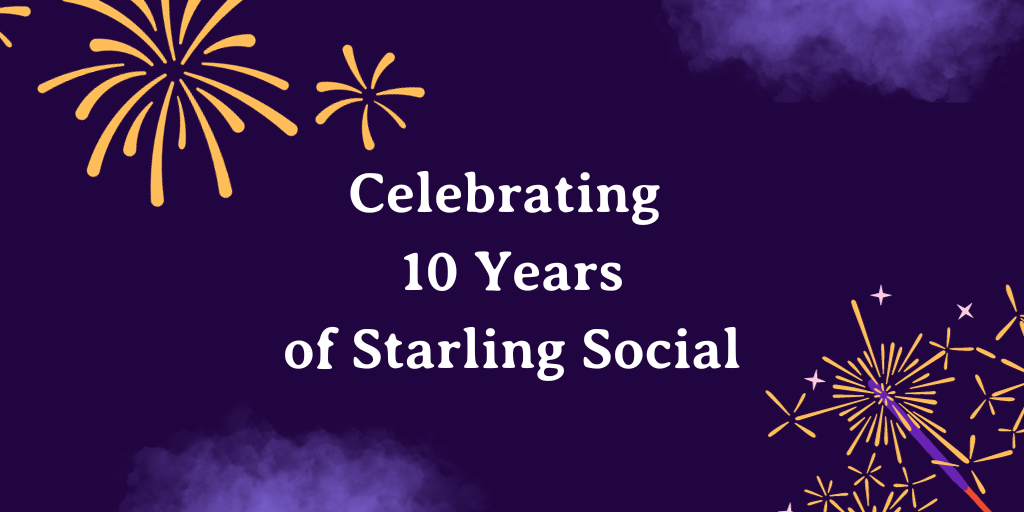
Written by Alyson Shane, President.
In July of this year I’ll have been working for myself for 10 years.
Saying this out loud, or even writing it, feels surreal. Not just because of how quickly the time has passed, but also because I’m in this position at all.
Which is why today I want to share the backstory behind how I got into my industry, the inspiration behind Starling Social, and a little bit of what drives me to be the kind of business owner and leader that I am today.
My Story
I never expected to run a business. In fact, I never expected to achieve much beyond scraping by at a 9-5 for most of my life.
I had a complicated home life as a kid - I was emotionally and verbally abused, and even moved out to live with friends for a while in Grade 12. I struggled with anxiety that was so intense that I couldn’t focus in school, and as a result my grades were so bad that I didn’t graduate high school on time.
I went to summer school to complete my diploma and worked a string of low-paying retail and fast food jobs for a few years after graduating. I was miserable and directionless.
I moved to Ontario and lived in Hamilton and Toronto for a while, but wound up coming back to Winnipeg as depressed as when I’d left, even though I’d managed to score a job working for the Provincial Government when I came home.
A “safe” union job should have felt like a blessing, but it compounded the negative feelings I had about my life. I felt trapped in a role I didn’t like, in an industry that didn’t excite me, and I started having panic attacks every day and sliding further into depression.
Then, one day, I was sitting on the bus* and the song “Gifts” by Propagandhi came on and a lyric I'd heard hundreds of times before started playing:
“All the slightly insane on the 18 North Main…”
For some reason, this time, the lyric hit me like a ton of bricks.
I thought: this is me. I'm slightly insane on the 18 North Main.
I realized that I needed to pull myself out of my rut and figure out what I wanted to do with my life... but my high school grades weren’t good enough to get into university, so I signed up for night classes at the Adult Education Centre.
I spent the next six months working full time and going to night classes from 6 - 9 PM, Monday - Thursday. It was brutal and I was exhausted all the time, but the support and encouragement I got from my teachers and the Principal at the school (who fast-tracked me so I didn’t have to do the full 12 month curriculum) was incredible.
I’d never had “adults” in my life encourage me or say I was smart or capable enough to achieve my goals. It was life-changing.
I finished night school, enrolled at the University of Winnipeg, and began working towards my degree in Rhetoric, Writing & Communications.
While I was a student, an instructor from Red River College’s Creative Communications (CreComm) program reached out and asked if I’d start coming in to speak to first-year CreComm students about personal branding, blogging, and the importance of social media.
(If you know me, you know I’ve been publishing content online since 2002, aka the “pre social media era” and grew up immersed in how content has changed online.)
I was 21, a brand new university student, and suddenly I’d gone from feeling like a stupid nobody, to someone my peers and influencers in my community were looking to for inspiration and guidance.
I graduated with almost straight A’s (turns out I suck at Economics and at writing papers in AP style compared to the MLA style I was used to) and got a job working at a large, established marketing firm right out of university.
I should have been happy… but I wasn’t.
I still struggled with anxiety and, now, a heaping dose of Impostor Syndrome, and I had a hard time fitting into my role.
I spent the next few years jumping from job to job, never finding a fit and butting up against rules that didn't make sense, processes that felt outdated, and a lack of agency and creative control over my deliverables and workday.
Around this time I picked up a small freelance copywriting contract. It wasn’t much, just a few blogs a month for a small amount of money, but the idea that I could make money on the side of my 9-5 was like a wake up call.
I said as much to my boyfriend (now husband) and he said: “You know, you could do this for a living if you wanted.”
At the time I shrugged him off; I couldn’t imagine myself leaving the safety and comfort of a reliable paycheck.
“Give it a year and see how it goes” he said “pick up a few more contracts and see how it feels.”
So that’s what I did… and within a year I was making more money freelancing than I was at my 9-5.
I started working for myself that summer and I’ve never looked back since.

(I got a tattoo of the Propagandhi lyric on my arm to celebrate my 1st full year as a business owner, and to remind myself of how far I've come.)
Starting Starling
I managed things by myself for the first few months, but after landing what felt (at the time) like a huge contract with a sales consulting firm based out of New York, I realized that I needed to bring on supports; I couldn’t scale this on my own anymore.
I started bringing on team members to support the workload I’d built and realized that freelancing as “Alyson Shane” wasn’t going to cut it if the people my clients were talking to day-to-day weren’t me.
Why “Starling” Social?
It wasn’t that hard to figure out what I wanted to call my agency.
I’ve always been attracted to starlings. They’re a beautiful, interesting bird, and “murmurations of starlings” - the name for when large groups of the birds fly in mesmerizing patterns through the sky - is one of my favourite expressions.
Starlings are songbirds, and mimics. In addition to their stunning performances in the sky, starling’s are known for being able to mimic sounds, other animals… even humans!
As a marketing agency, our goal is to “mimic” our client’s brands and sound like them, so the link between the bird, and the agency, fell naturally into place.
Building Out Processes
I never went to business school. Heck, I’m a digital marketer who never even studied marketing!
Everything I know has been self-taught, either through hands-on experience or by consuming as much material about a subject as I can.
I taught myself to build out processes to keep my fully remote team connected and productive
(this was in the pre-COVID era when being a fully remote business was less common)
and I’ve invested heavily in training sessions like one I did with Hatch London where I spent three intense days learning the ins and outs of building successful Facebook (Meta) Ads campaigns.
I’ve gone through startup accelerators like YCombinator’s Startup School to learn business strategies and how to think strategically about managing a small, agile, and nimble team without investing in too much overhead and developing systems
I’m also a voracious reader and have an intimidatingly long RSS Feed of websites, blogs, and resources that I check every day so I can stay at the top of my game.
I also curate and write Starling Social’s weekly digital marketing newsletter every week as a way of keeping myself accountable and keeping my skills as sharp as possible.
(If you want to subscribe to that, you can do so here.)
Identifying Differentiators
Let’s be real: in a city where the CreComm program, alone, graduates hundreds of students a year, it sometimes feels like you can’t turn a corner without bumping into another digital marketer or agency owner.
In a city like Winnipeg, you really have to lean into what makes you different - luckily I’ve got heaps of that in spades!
It took me longer than I’d like to start leaning into these differentiators (hello, Impostor Syndrome) but some of the things we bring to the table include:
- My 22 years’ experience publishing content online. I started publishing in the pre-MySpace era (hello, Geocities!) and have hands-on experience crafting content, telling stories, and using every social network as it’s evolved to understand how they work together, and what makes them different.
- My degree in Rhetoric, Writing & Communications. Unlike a lot of my peers, I studied persuasive language, so I have an academic-level understanding of how humans communicate, how we do it differently across different mediums, and how it’s changed over thousands of years.
- I’m a writer. In my view, this is the biggest competitive advantage I have as a marketer. I love writing and do it for fun, and because of my experience I’m a fast, adept, and efficient writer. This also means I hold my team to an extremely high standard when it comes to the content we create for our clients.
Making It Work
Building a successful agency is more than a clever name and a great tech stack - you have to constantly work at it and find new ways to learn, grow, and build connections.
I say this all the time, but the main reason that I was able to scale Starling Social as quickly as I did was because I was a “big fish in a small pond” - I practically lived on Winnipeg Twitter, building connections and making sure people knew who I was, and I blogged regularly and used my writing skills to publish useful how-to articles, guides, and strategies that reinforced me as a subject matter expert.
To date, over 90% of Starling Social’s local business has been referral business, and most of our national and international clients have also come from connections I made at conferences, online, or through friends-of-friends who’ve referred us.
Sure, I have a sales partner who helps generate leads for me, but that business is a drop in the bucket compared to the work we’ve done thanks to good old-fashioned personal branding and networking.
I also do a ton of public speaking (I average about one talk, webinar, or podcast interview per month) which not only keeps me fresh, but also allows me to empower others and share the knowledge I’ve built over my decades publishing online, and my almost-decade working in this industry.

Teamwork Makes the Dream Work*
All this being said, my efforts wouldn’t mean much if I didn’t have a team of incredible humans behind me.
The talented, driven, and creative people at Starling Social handle the day-to-day interactions with our clients so I can do all the fun stuff I just outlined above.
I’ve learned to lean on my team and to make sure that they always feel like they can lean on me, too.
I take what I do seriously for myself and my clients, of course, but mostly I put in effort for them. I want them to feel confident and secure in my leadership, and to know I’ve always got their backs.
(I often say “my job is to make sales, close leads, and eat sh*t so you guys don’t have to.”)
One of my tenets is “if it’s not written down, it doesn’t exist” and as a writer this is one of the things that sets me apart from other agencies: I have extremely well-documented, repeatable processes for almost everything we do.
When we need to solve a new problem, I get down in the trenches with my team and spend time developing how-to guides that they can use and come back to - this eliminates guesswork, helps them be more efficient, and ensures consistently high-quality output whether we’re in the same room or not.
I don’t just do this because I’m an A-Type person; I want to empower my team to do their best work, and they’re less likely to succeed if they’re muddling through a problem, or constantly asking me for advice on how to do something.
This approach also shows my team how committed I am to their success, which (as I said above) is the most important thing to me.
* Sorry/not sorry to Alicia who hears me say this like every other day, haha.
What’s Next?
Looking ahead, I’m excited about what’s to come.
I feel like I’m hitting a stride with my business, and that Starling Social is poised for even more growth and to partner on some impactful and important projects.
Starling Social has won multiple awards, I've personally won awards for my community impact through pro bono work we do, and we regularly receive glowing testimonials and feedback from our happy clients.
I get to work with friends (and clients who feel like they’re friends), do creative work that I enjoy, and build a life for myself and the people who work for me that allows us to (mostly) have a healthy work/life balance, take trips, and soak up the best of what our city and community has to offer.
I don’t know what the future holds, but from here it’s looking brighter than ever.
Cheers to 10 years, and to many, many more!

